Pieces of the Sky

Earth is bombarded by a constant rain of debris from space. Most of it is fine dust that drifts down to the surface. Other pieces can be as small as a grain of sand or larger than a house. We see flashes of light when pieces of comets, asteroids, and other planets fall through our atmosphere.
After these bits of the sky land on Earth, they are collected as meteorites. We study space rocks to learn more about the formation of our solar system and the evolution of our planets.
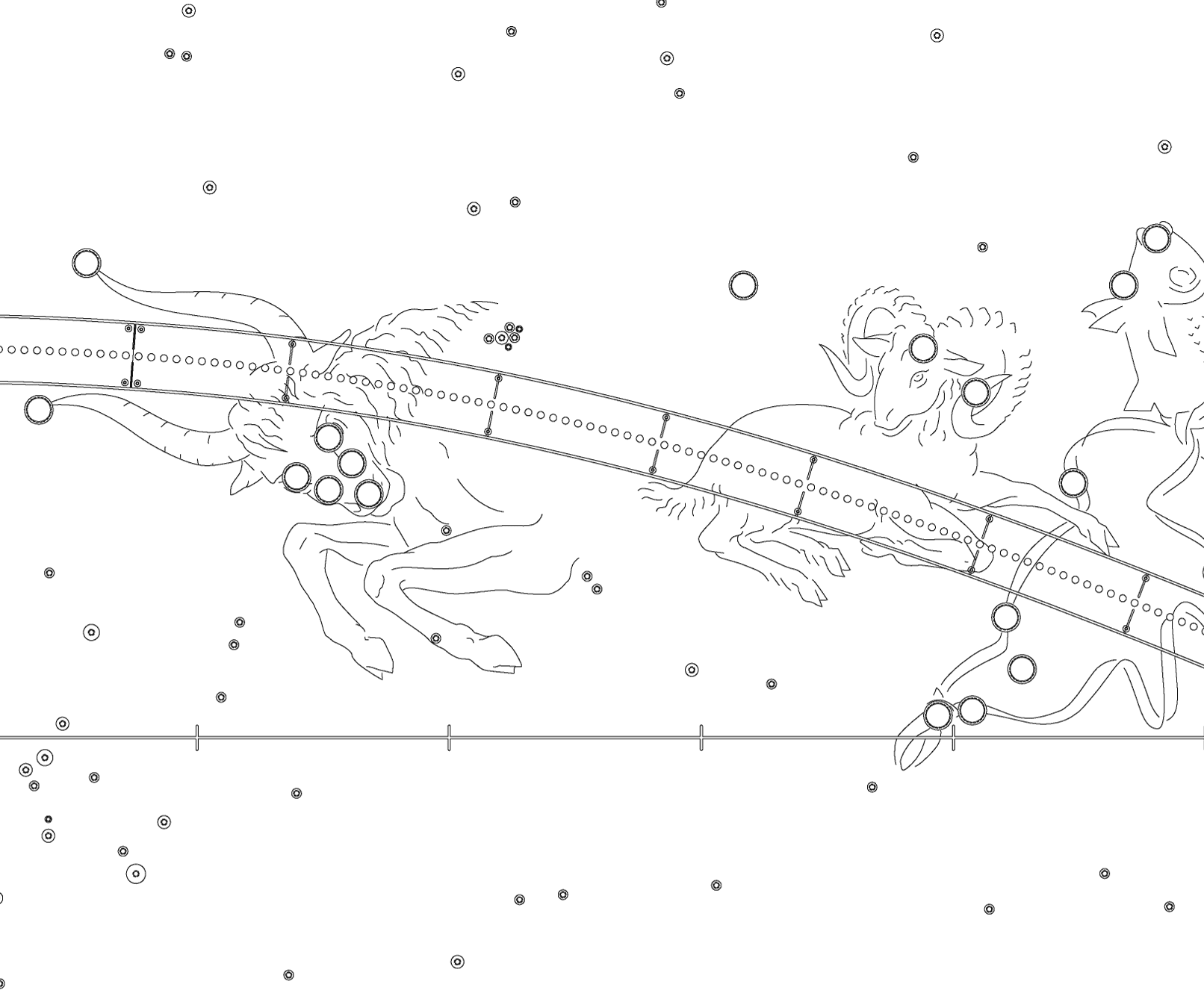
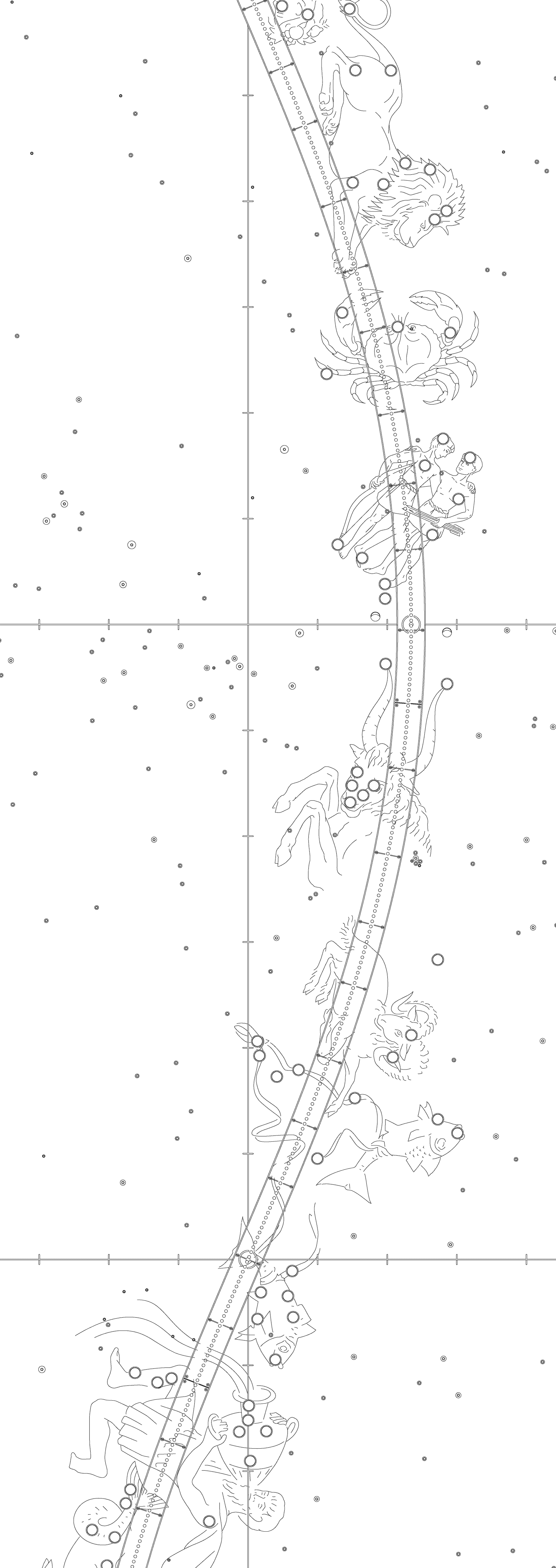
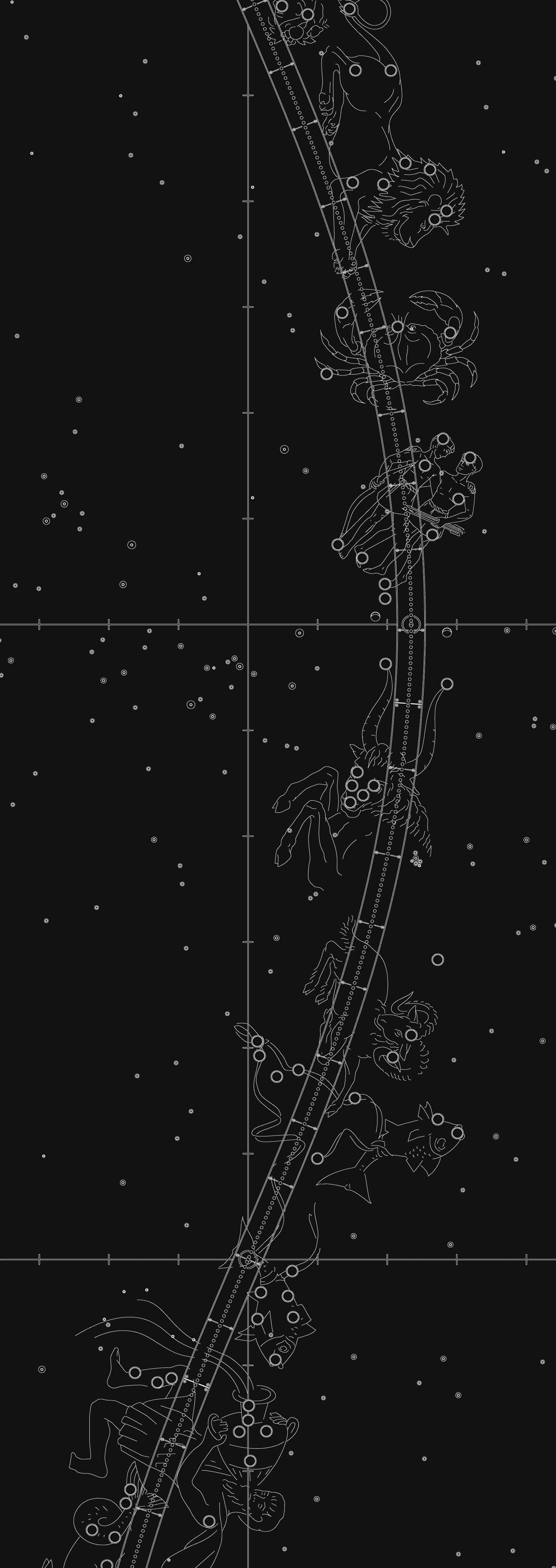
Meteors and Comets
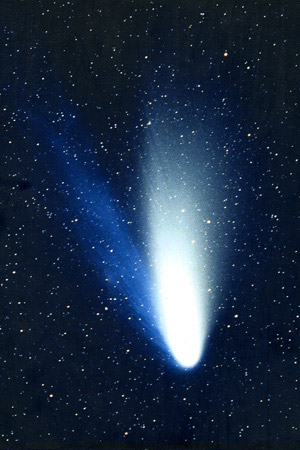
Pieces of comets and asteroids fall from space and cause the flashes of light in the sky that we see as meteors.
The space between the planets is not empty. It is filled with dust shed from comets and fragments of broken asteroids. As Earth’s orbit takes us through this debris, pieces of it enter our atmosphere. The smaller ones burn up because of friction with air molecules. The resulting flashes of light in the sky are meteors. Anything that survives the trip and lands on the surface is then called a meteorite.
The smallest and most plentiful particles come from comets, which contain ice and dust. As they orbit the Sun, Comets scatter dust along their paths. When Earth’s orbit takes us through those dust trails, the material enters our atmosphere and vaporizes. The smallest particles generate very little friction with our atmosphere and drift gently down to the surface. Meteors in showers come from comets.
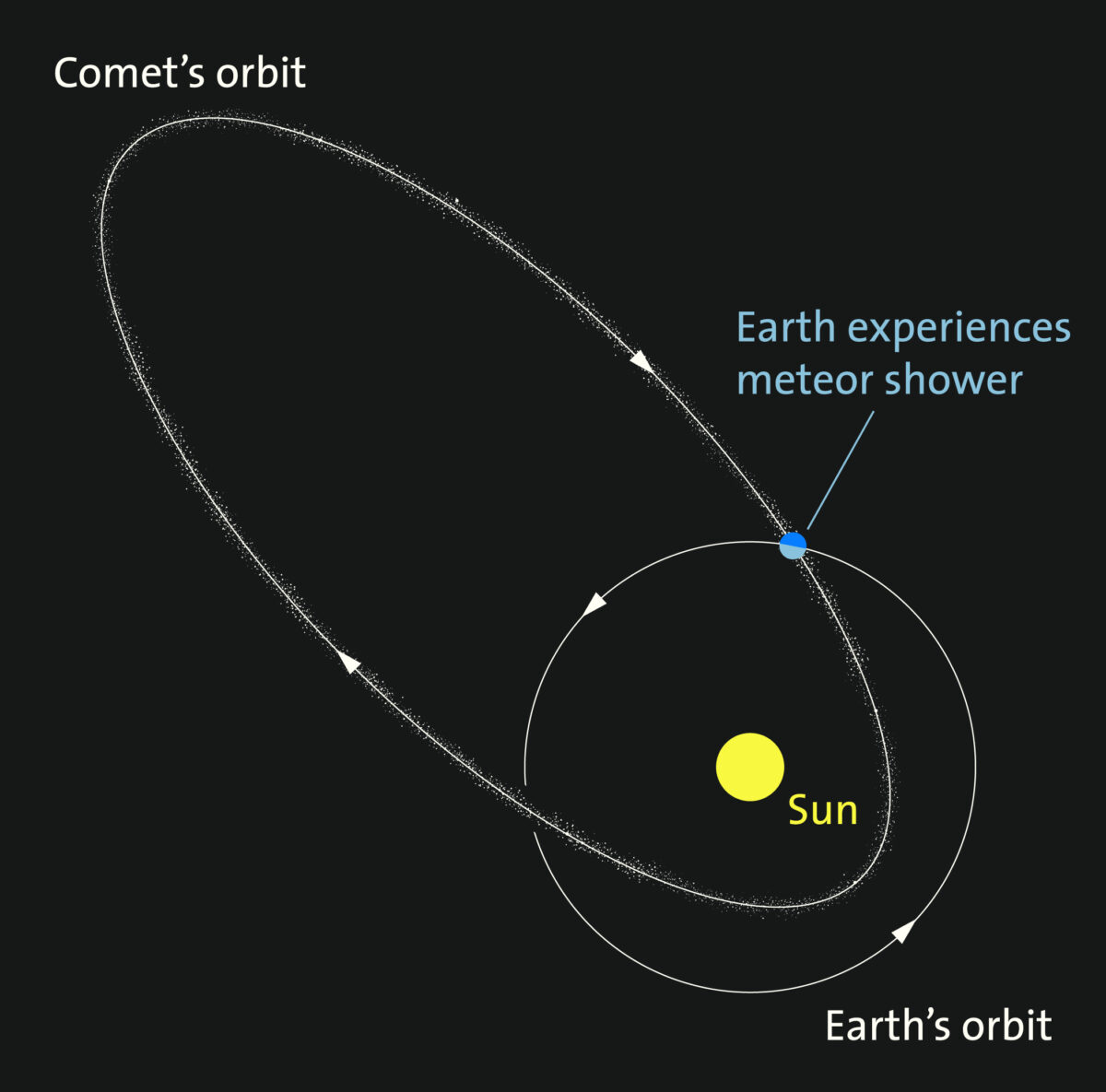
Larger pieces of the sky generally come from asteroids, or minor planets. When asteroids collide, they scatter rock fragments throughout space. Eventually, some land on Earth. A few rare meteorites come from the Moon and Mars.
Meteor Showers Come from Dust in Comets
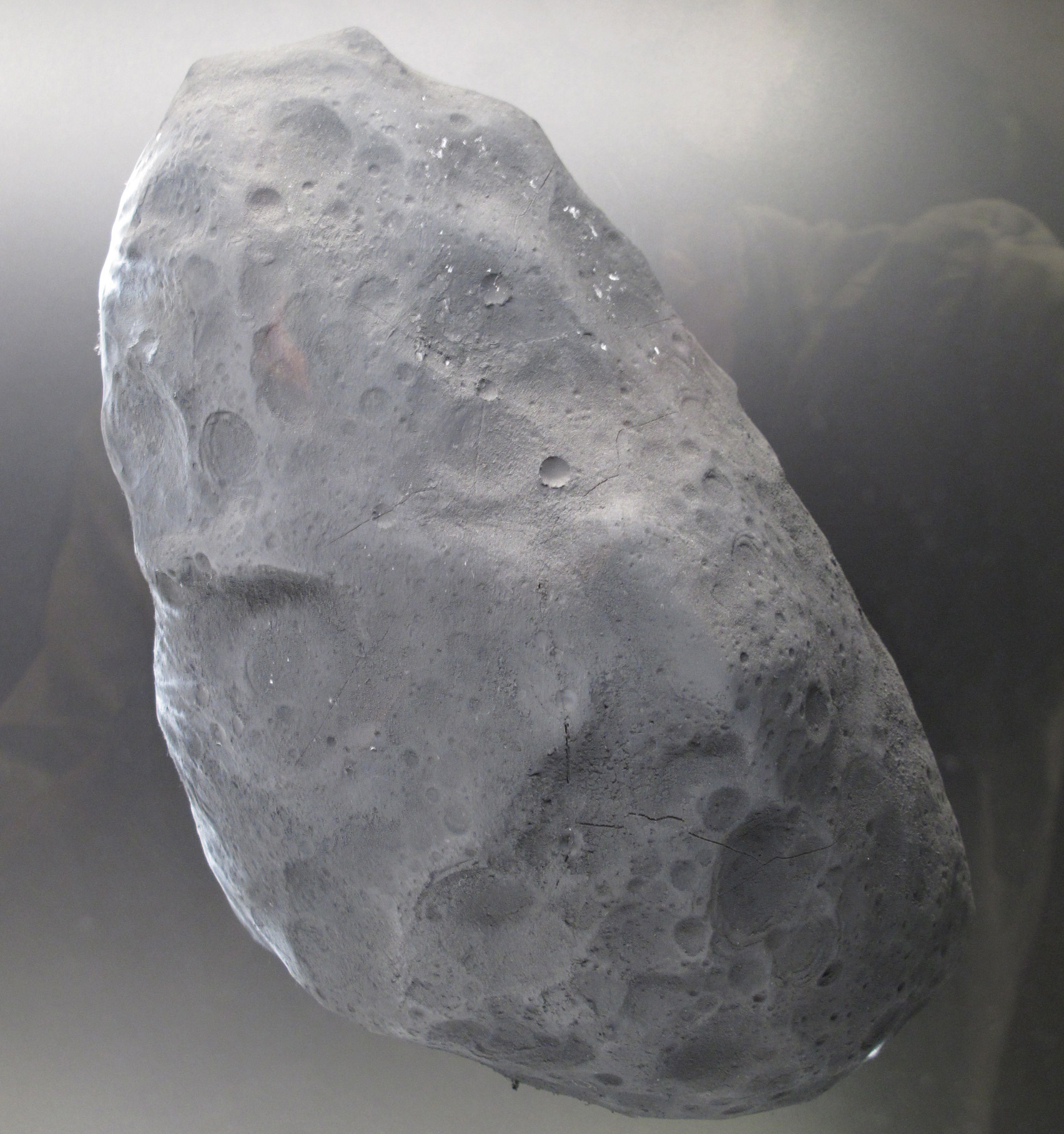
A comet nucleus is made of ice and dust, and formed in the original nebula where the Sun and planets were born. It is mainly water ice, with some methane and ammonia in the mix. Its dust particles are rocky grains. As a comet nears the Sun, the surface ices evaporate and form a cloud. This material streams out behind the comet, and the dust tail scatters particles along the comet’s path. When Earth moves through the dust trail, we get meteor showers. This model shows a typical comet nucleus with a dark, crusty surface coating that forms after the comet has rounded the Sun a few times.
Compared with a planet like Earth or Jupiter, the nucleus of a comet is very, very small. Most comets are somewhere between the size of a boulder and a city. Compared with the nucleus, a comet’s dust particles are extremely small. They range in size from a grain of sand to a tiny speck no larger than the dust we find on our furniture.
Comet Dust
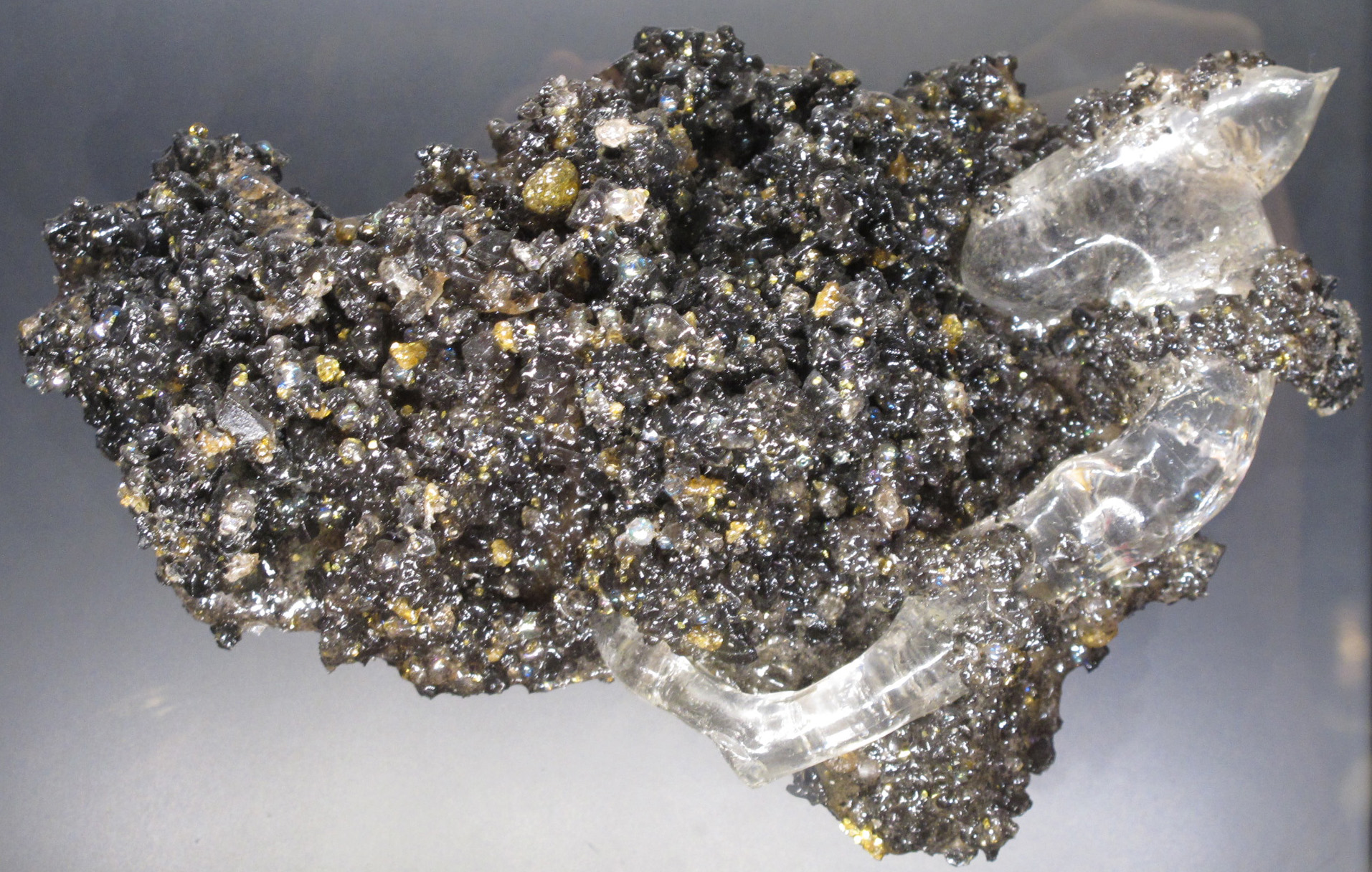
This is a model of a comet dust grain magnified 20,000 times. It simulates the look of dust from a comet that formed near the orbit of Pluto 4.5 billion years ago. The dust particle after which it is modeled was gathered by special collectors mounted on an aircraft.
The 1833 Leonid Meteor Shower Makes History
“In the year 1833 a most remarkable phenomenon occurred. It was called the falling of the meteors. It happened in the night, and as I was only a small child, I heard my parents describe it the next morning as being the most awful sight that was ever looked upon with mortal eye. They said that the firmament on high was one solid glare of fire and light, and looked as though every star in the sky was falling to the ground, and that they were certain that the Day of Judgment was at hand. There were many wicked men on their knees that night, praying to the Lord, and calling on other to pray for them, that had never been known to bow in prayer before.”
– From the diary of Mary Hansard, Age 8
What Happens to a Meteor on Its Way Down to Earth
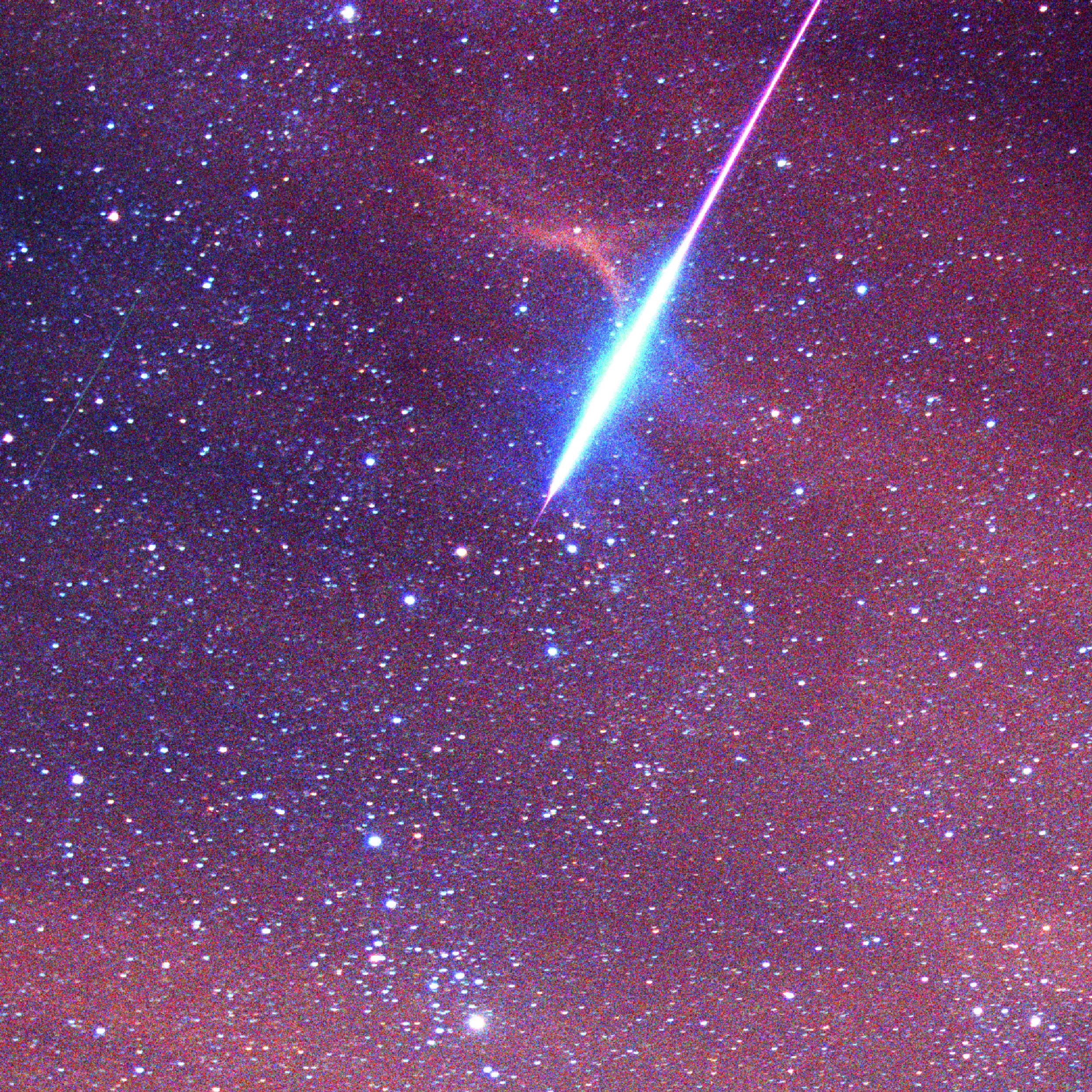
Every day, countless objects that came from comets and asteroids fall to Earth. What happens when they hit the atmosphere depends on their size and composition. Most of these particles are the size of dust grains. They simply float down to the surface. Slightly larger objects – the size of a grain of sand or a pea – are slowed by the atmosphere. They glow from the heat of friction and eventually burn up. The resulting flash of light is a meteor. Under a dark sky, you can see several meteors an hour on a typical night.
Incoming objects enter the atmosphere at average speeds of 12 miles (20 km) per second. Friction heats them to 8,500 degrees F (4,700 degrees C) and slows them down. Large objects and those made mostly of iron often survive their trip through the atmosphere and fall to the surface as meteorites. The very largest ones continue glowing all the way down, making spectacular fireballs.
When Rocks Fall to Earth
Small pieces of space debris burn up as they pass through the atmosphere. We see their glow as small meteors. Only the largest, most solid pieces of rock and iron survive the fiery descent. We see them as fireballs. These larger pieces are heated and softened by atmospheric friction. The air pressure they encounter may cause them to explode into fragments just before they hit the ground. Those pieces land on the surface or bury themselves in the dirt.
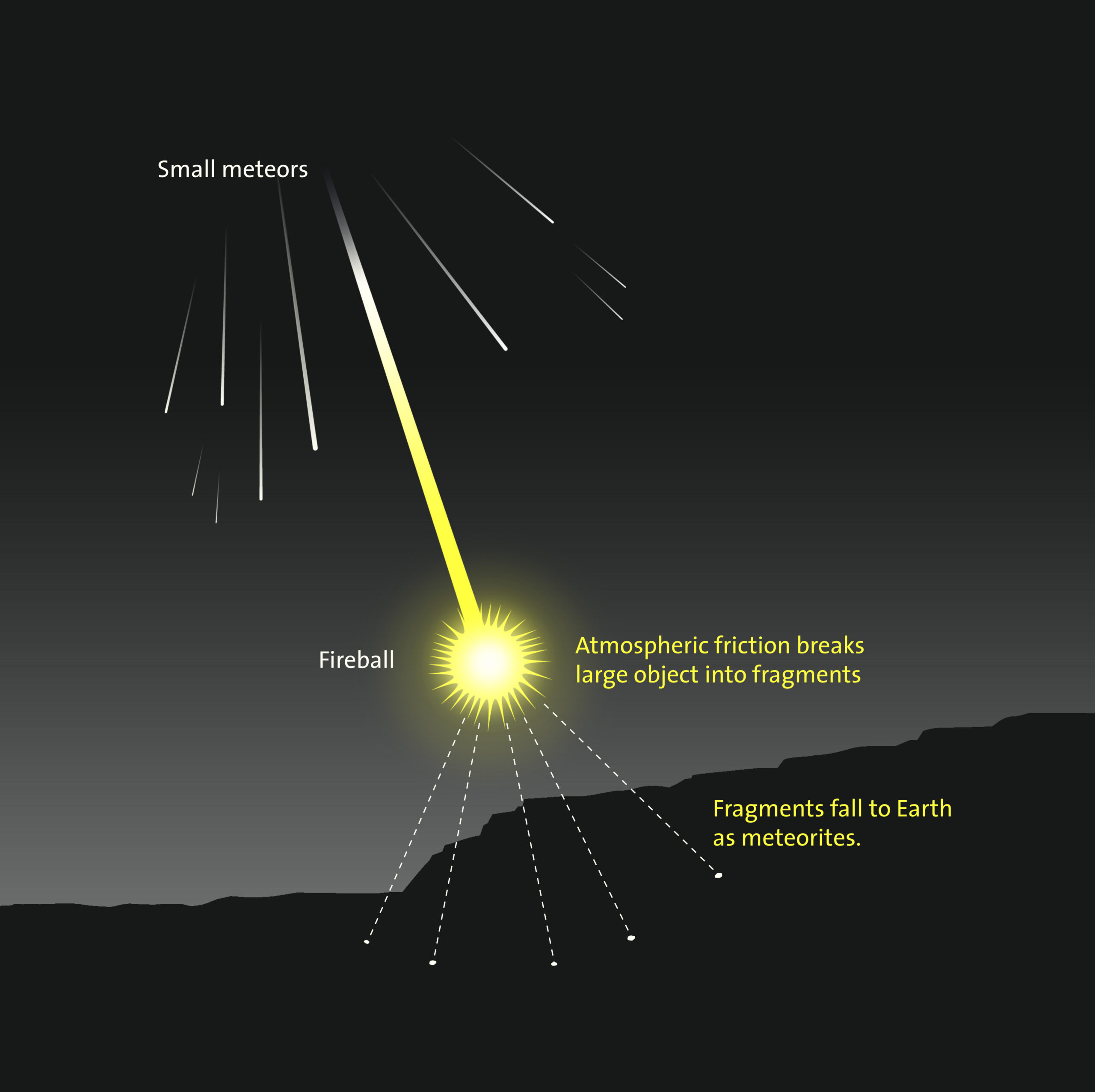
The force of a large impact blasts out a crater like those on the Moon and sends material flying out from the impact site. Some of the Earth’s craters are more than a hundred miles across, though most have been covered or eroded away.
Dust From Space
Look through the microscope to find tiny pieces of actual asteroid or comet dust. They are smaller than grains of sand. Some space dust particles began their journey to Earth when they were blasted from an asteroid during a collision or shed from comets passing near the Sun. The dust drifts through interplanetary space until it encounters Earth’s atmosphere.
The largest space-dust particles fall through our atmosphere and flash as meteors we see in the sky, especially during meteor showers. Most space dust is vaporized before it reaches Earth’s surface. The particles shown here survived the journey, melting into spherical shapes on the way down. They were collected from a water well at the South Pole in Antarctica.
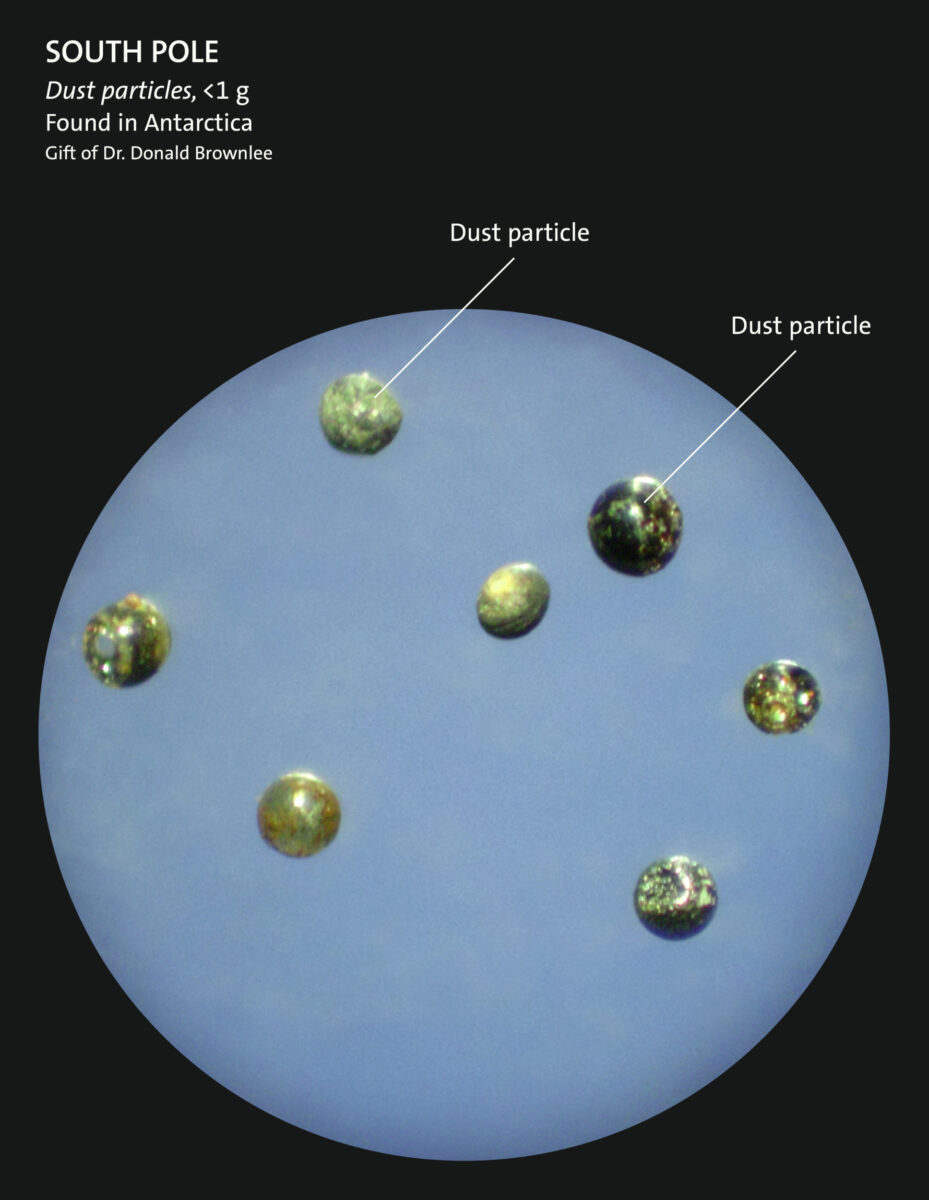


Meteorite Origins
Meteorites have their origins in the larger bodies of the solar system. They come from asteroids and from the surface of the Moon and Mars.
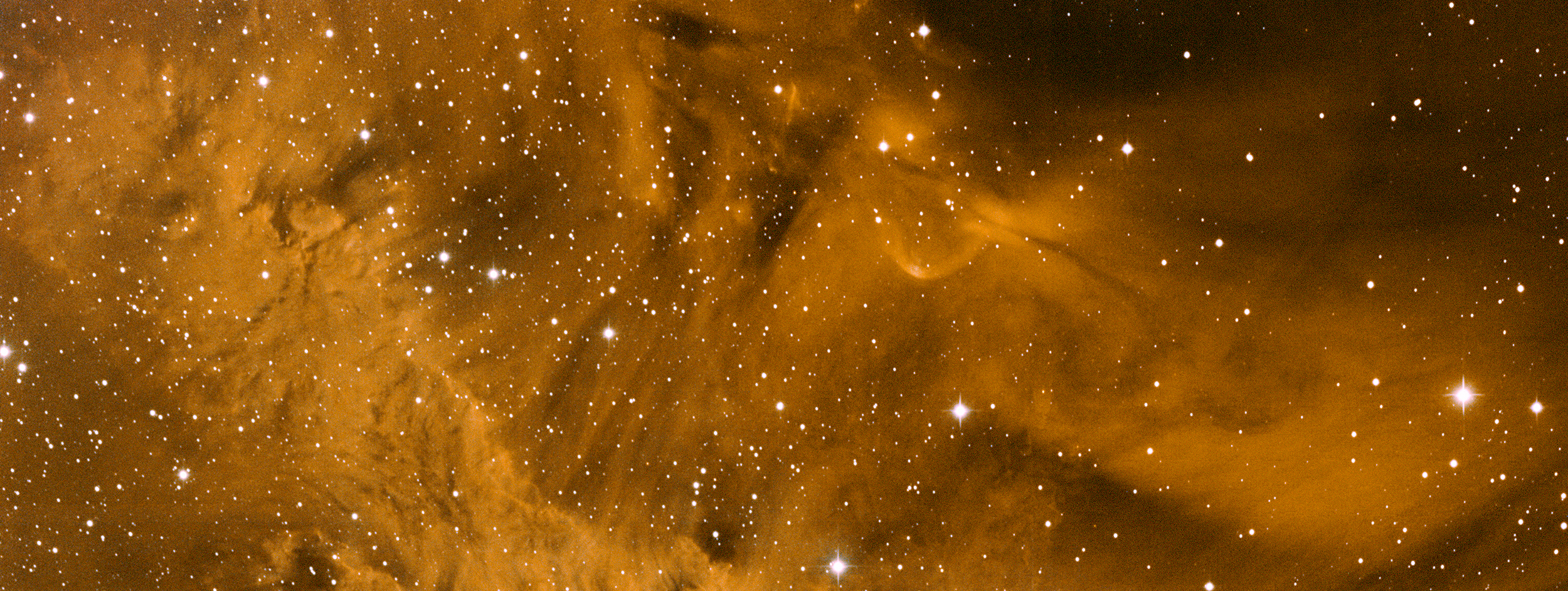
Most meteorites come from asteroids, the remnants of smaller planetary bodies that formed at the same time, and out of the same basic material, as Earth and other rocky planets. Many of these “mini-planets” were shattered by collisions with one another. Asteroids are the debris. Countless numbers of them orbit through interplanetary space. Most are found between Mars and Jupiter in the Asteroid Belt.
Most Asteroid Belt objects are not a threat to us because they tend to stay in their orbits around the Sun. Occasionally, a collision knocks one toward Earth. There are more than a thousand of these Earth-approaching asteroids. If one were to hit our planet, it could cause a catastrophe like the one that killed the dinosaurs. Fortunately, these are rare occurrences. Tiny chips of asteroids, however, fall through our atmosphere all the time.
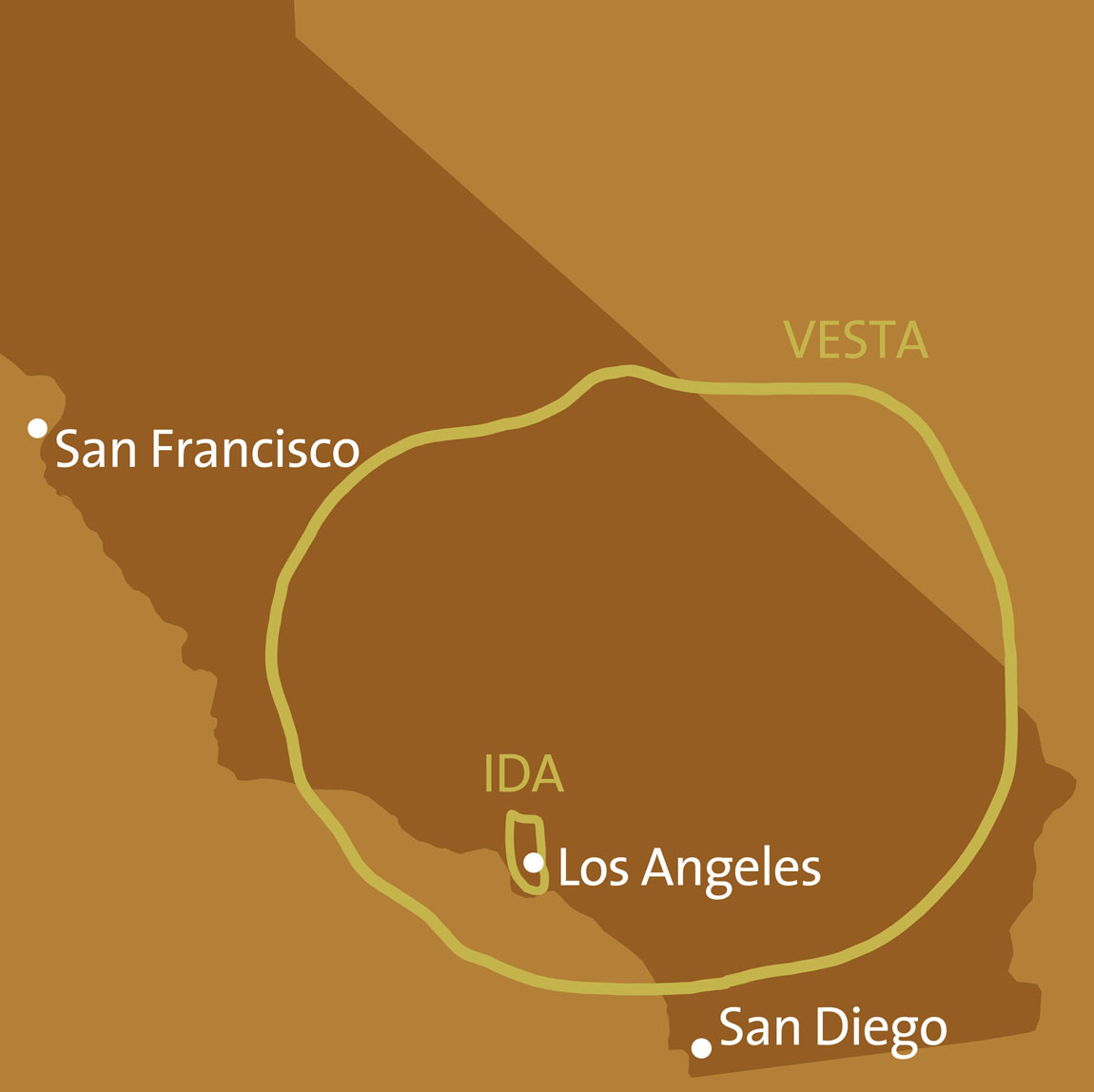
Asteroids are much smaller than Earth. Vesta is about 320 miles (515 km) in diameter, and it looks much like it did when it first formed. City-size Ida was once part of a larger asteroid smashed in a collision.
Meteorites From Asteroid Vesta
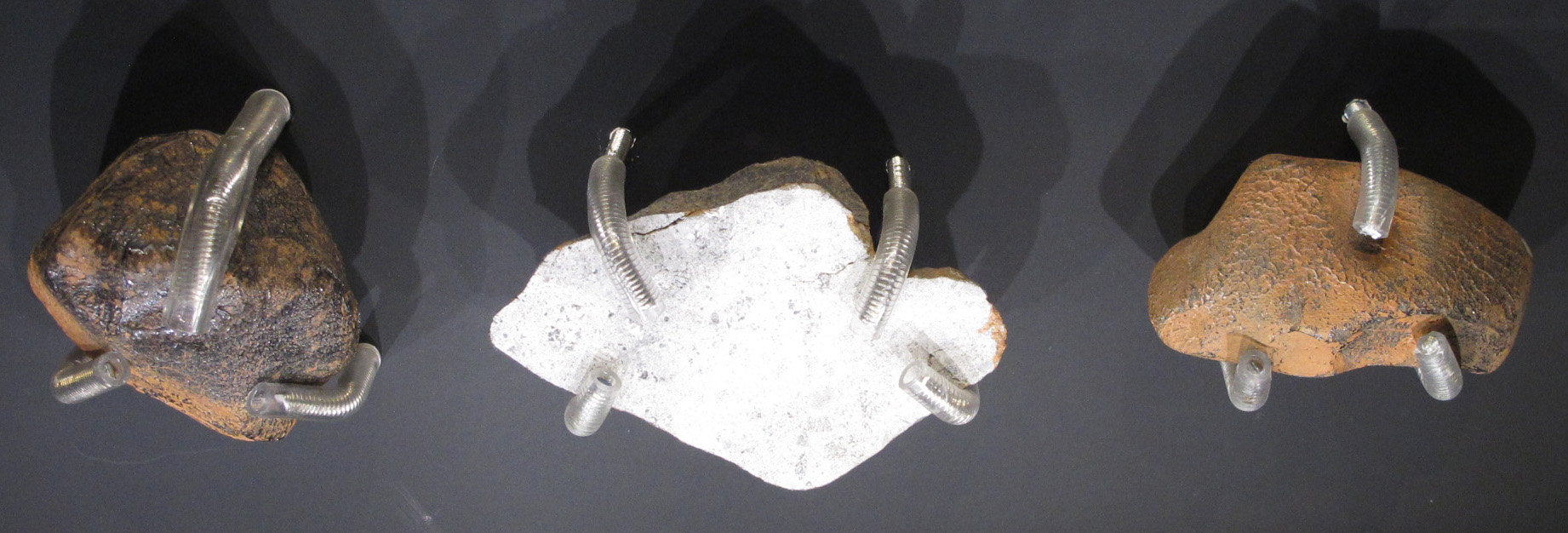
Only a few meteorites can be linked to a specific asteroid. These probably fell to Earth from Vesta, which formed when the solar system was very young. It has the same rocky composition as Earth, and evidence of ancient lava flows on its surface.
Smaller Asteroids
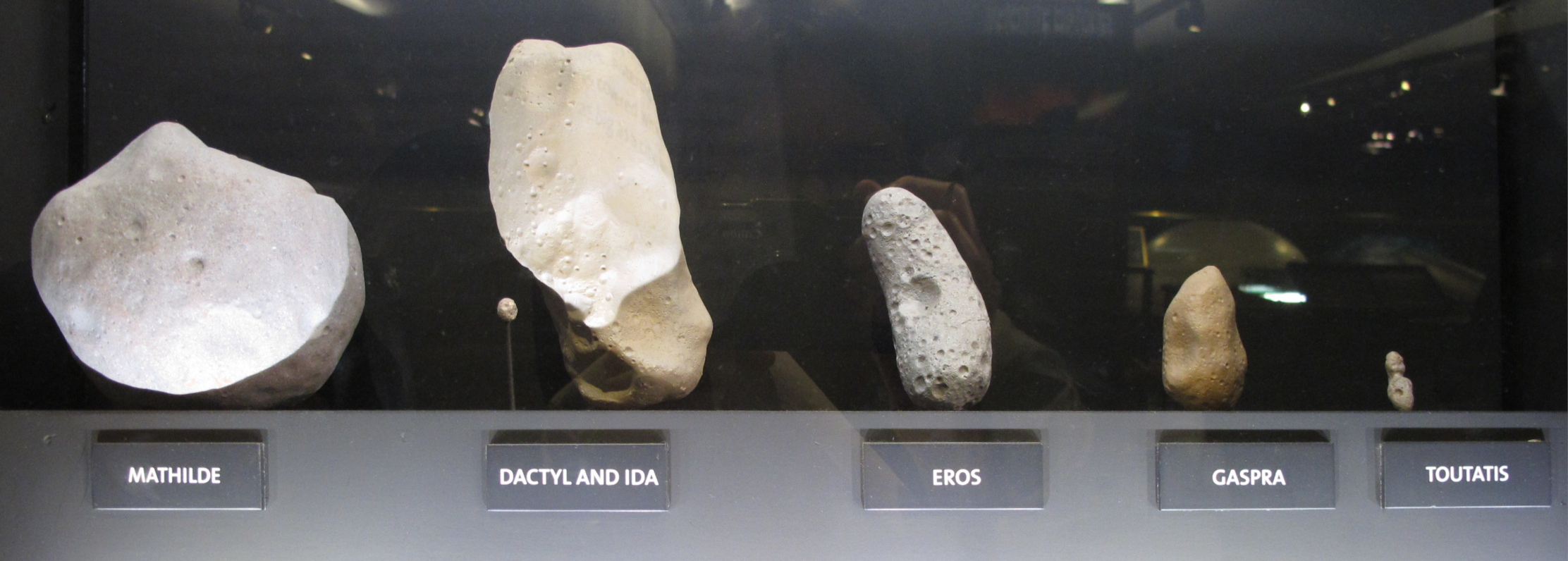
Each of the asteroids modeled here was photographed by passing spacecraft or imaged by radar. The differences between them tell us about their compositions and histories. Most asteroids are fragments of the original mini-planets. Their battered surfaces, strange shapes, and erratic movements are clues to the collisions they have experienced since forming. Mathilde is darker than charcoal and irregularly shaped. Ida is a lumpy, cratered asteroid with its own tiny moon, Dactyl. Oddly shaped Eros was the first asteroid visited by a spacecraft. Asteroid Gaspra was once part of a larger object and is covered with craters. Toutatis has a smooth surface, is a big as a city, and tumbles wildly through space.
Allende Meteorites, 1969
On February 8, 1969, a blue-white fireball streaked across the early-morning sky above rural northern Mexico. A tremendous explosion followed, as a piece of space rock weighing several tons broke into bits. As the fragments fell, the commotion woke up the villagers of Pueblo de Allende. Soon people began gathering samples of what came to be known as the Allende meteorites.
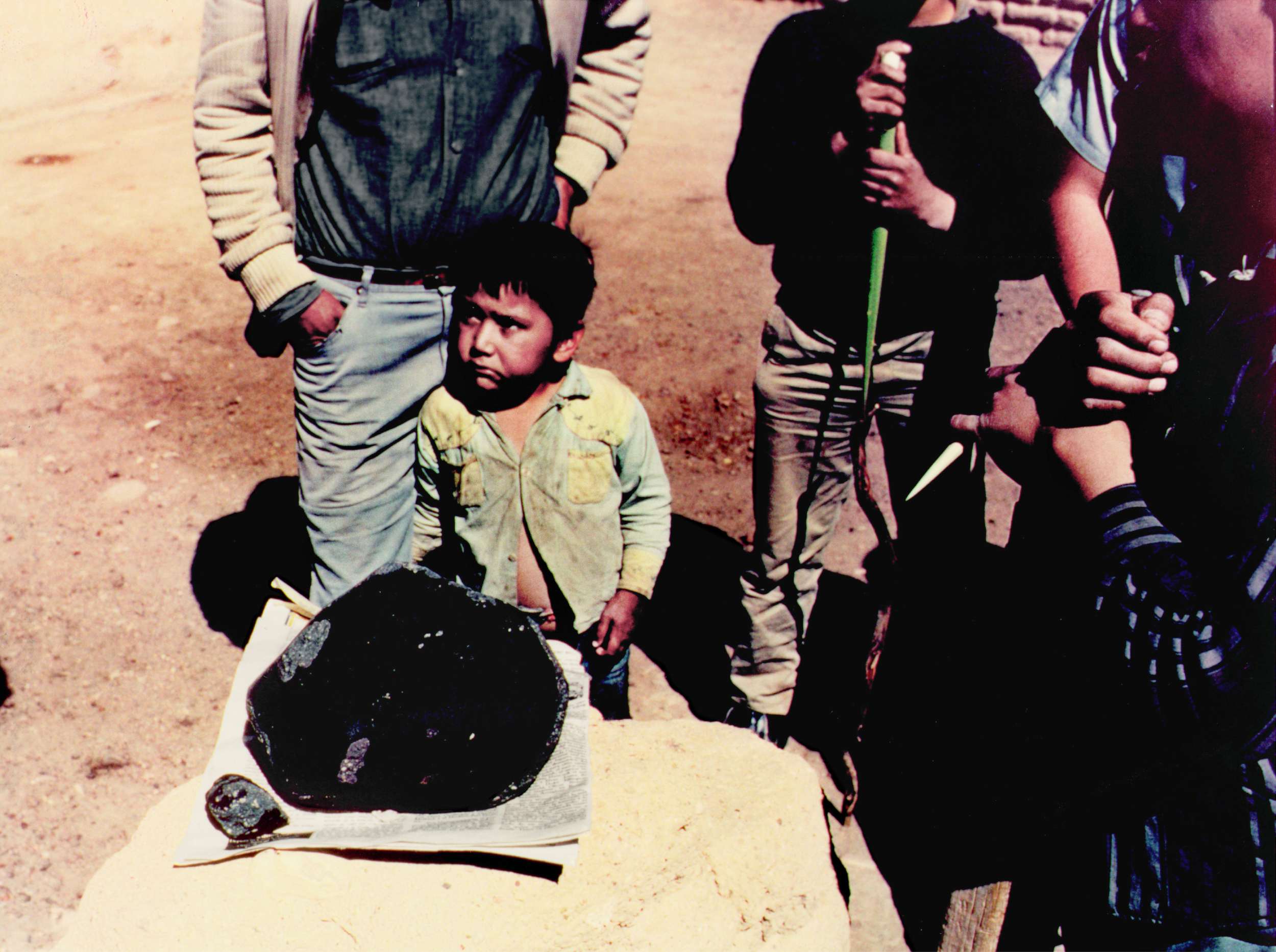
The Village was not far from Houston, so the meteorites were taken to NASA’s Johnson Space Center. The fall occurred just before astronauts brought back the first Moon rocks, and NASA scientist were still testing ways to analyze lunar samples. The Allende samples were a perfect test of their methods, using real space rocks. To everyone’s surprise, the meteorites turned out to be the same kind of rock that formed the inner planets and asteroids. This discovery revealed what the material in the early solar system was like.
Allende and the Early Solar System
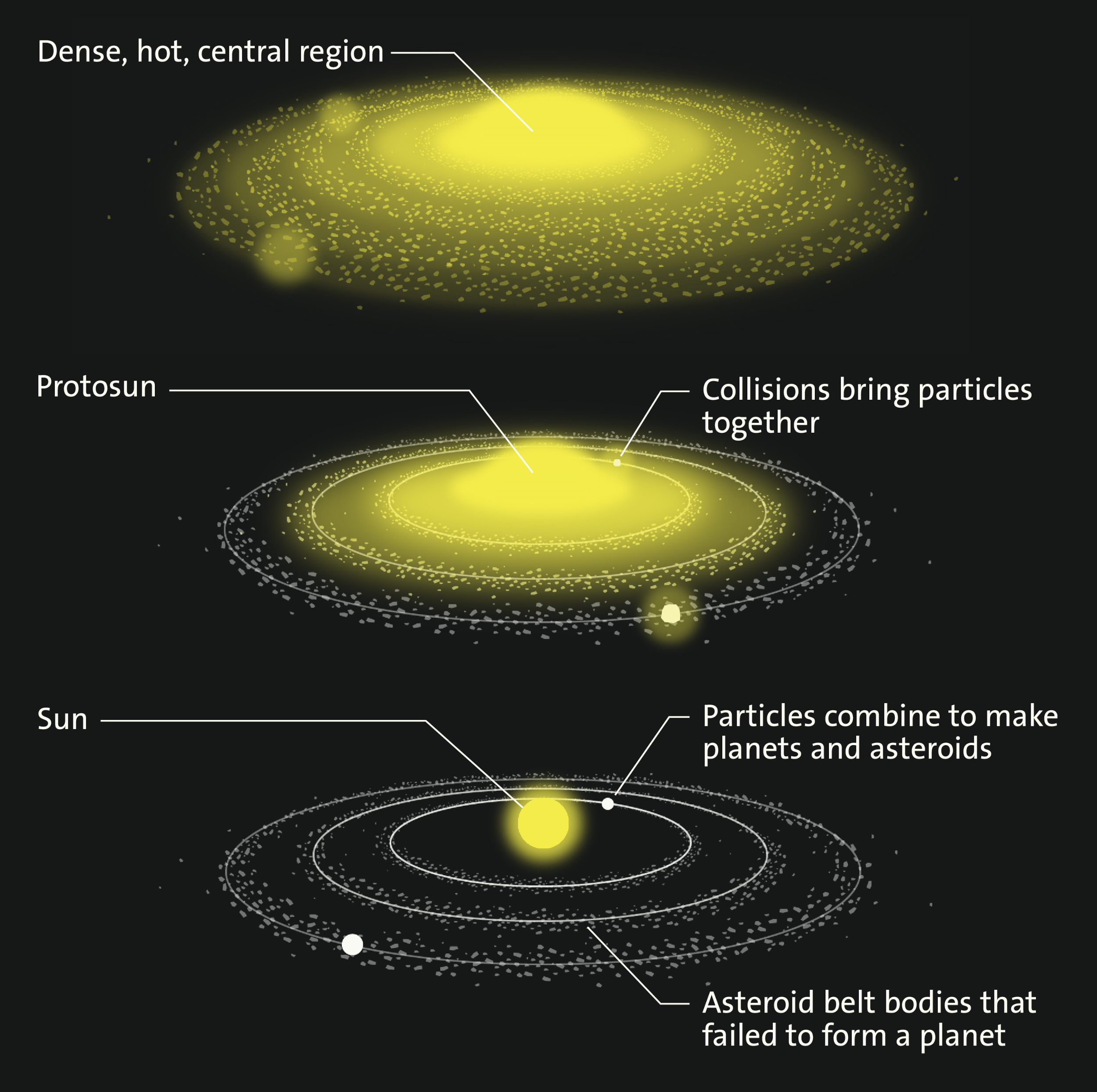
Allende meteorites are pieces of very ancient solar system history. They contain some of the rocky material that existed before the planets and asteroids formed. The presence of these materials tells scientists that meteorites like Allende have not melted since the birth of the solar system, more than 4 billion years ago.
Pieces of Solar System History
The polished slice of Allende meteorite in the microscope is a piece of the very early solar system. This specimen contains chondrules. They formed from dust grains that existed in the cloud of gas and dust where the Sun and planets were born. These grains melted and cooled to make the tiny beadlike spheres you see here. Rock fragments and other materials are also mixed with the chondrules. All these ancient building blocks combined in the solar system’s birth cloud to form ever-larger rocky bodies that ultimately became the asteroids and planets.
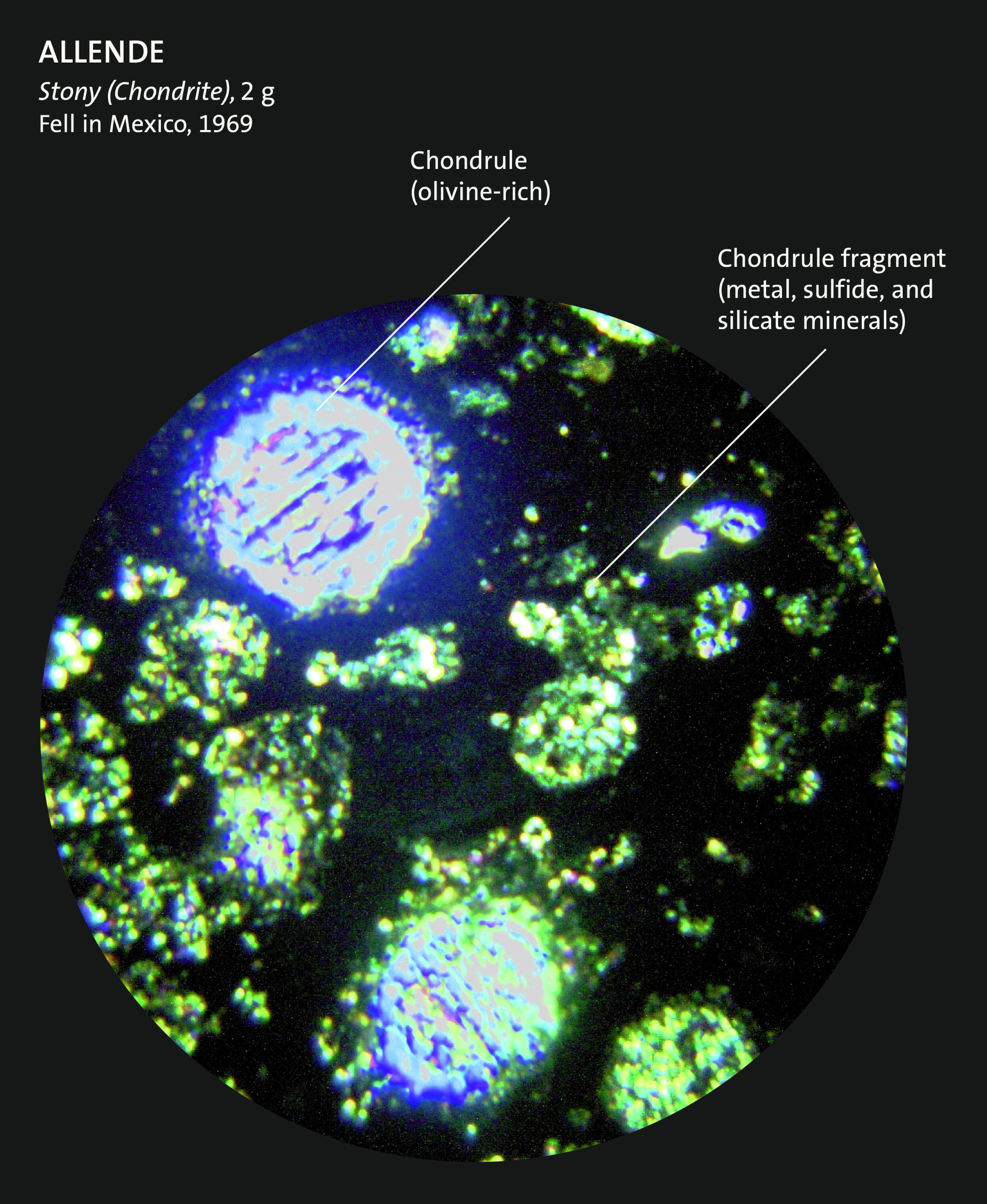
Pieces From Another World
Meteorite From Mars
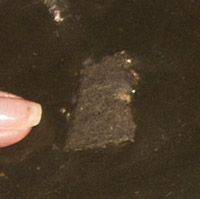
This Billion-year-old rock comes from a lava flow on Mars. About 20 million years ago, an object hit the planet and blasted pieces of the hardened lava into space. This one fell to Earth about 600,000 years ago. It was found in the desert of Oman (in the Middle East) in 2000.
Now do we know it came from Mars? Scientists study gases trapped inside meteorites they think are from the Red Planet. They compare their results to data taken by the Viking landers on Mars in 1976. Samples that match are probably from Mars.
Meteorite From the Moon

This chip from the Moon’s surface is a mixture of many kinds of rock and fragments of lava that melted together. A meteorite impact sometime in the distant past knocked it off the Moon’s surface. It fell to Earth and was found in Oman in 2002.
Astronomers analyzed the chemical elements in this meteorite and those in rocks brought back from the Moon by the Apollo astronauts. Since it matches the elements and minerals in the Apollo samples, we know this meteorite also came from the Moon.
Meteorite Histories
Asteroids are made of some of the oldest materials in the solar system. Asteroids formed more than 4.5 billion years ago out of the same rocky materials as the planets. Some of them have not changed since they were born. Others melted, formed layers, or were broken apart by collisions.


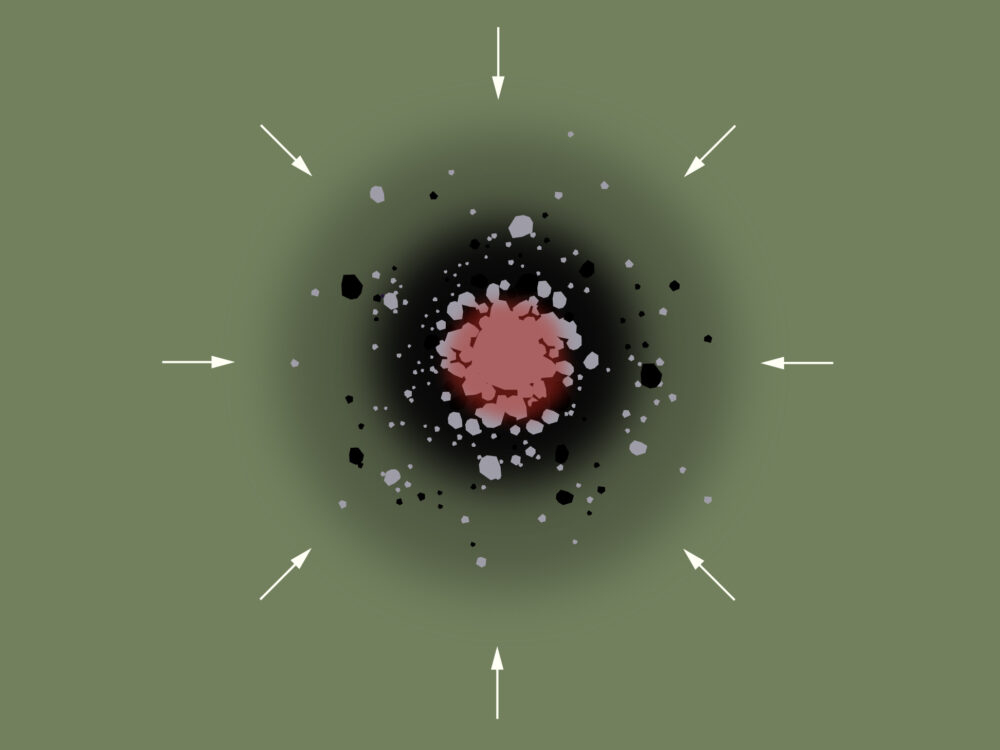
Formation
Countless large asteroids were assembled from chunks of material in the early solar system.
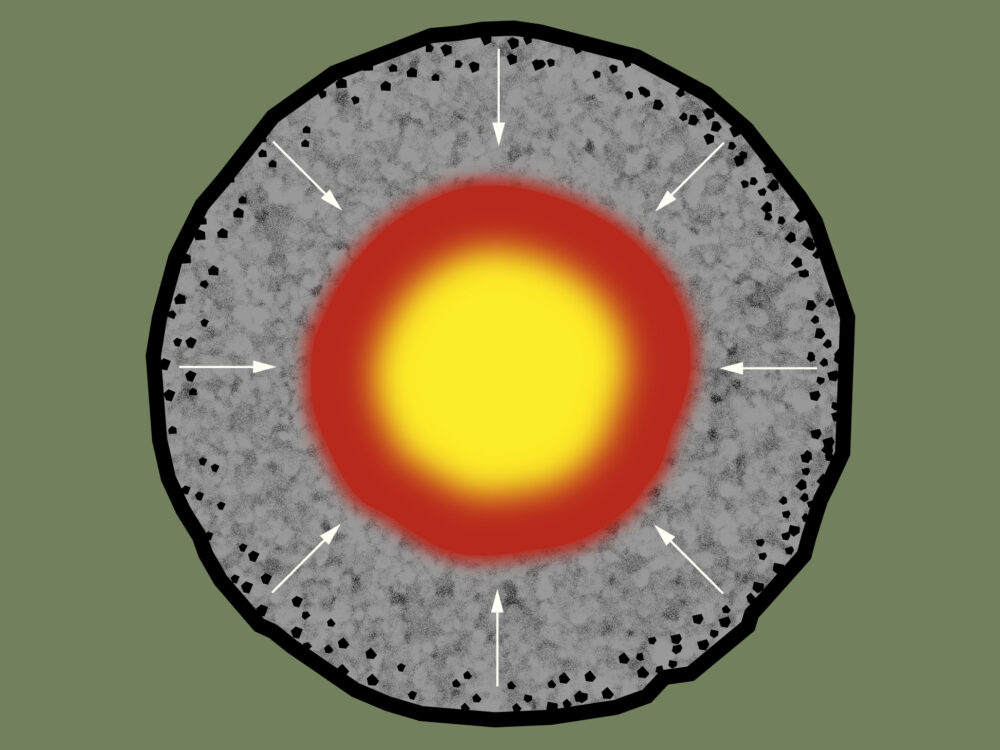
Layering
When some of the largest asteroids melted, iron sank to their centers and formed cores. Lighter rock floated up to create mantle and crust layers.
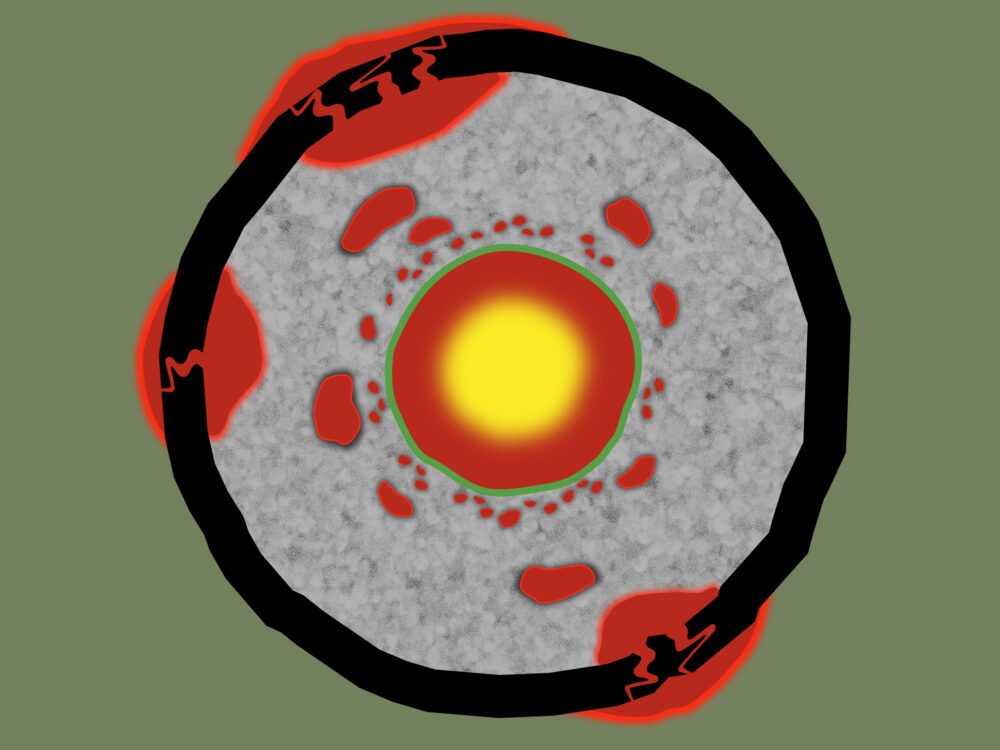
Activity
In a volcanically active asteroid, magma flows up to the surface from molten areas in the mantle. Lava flows have been found on several asteroids.
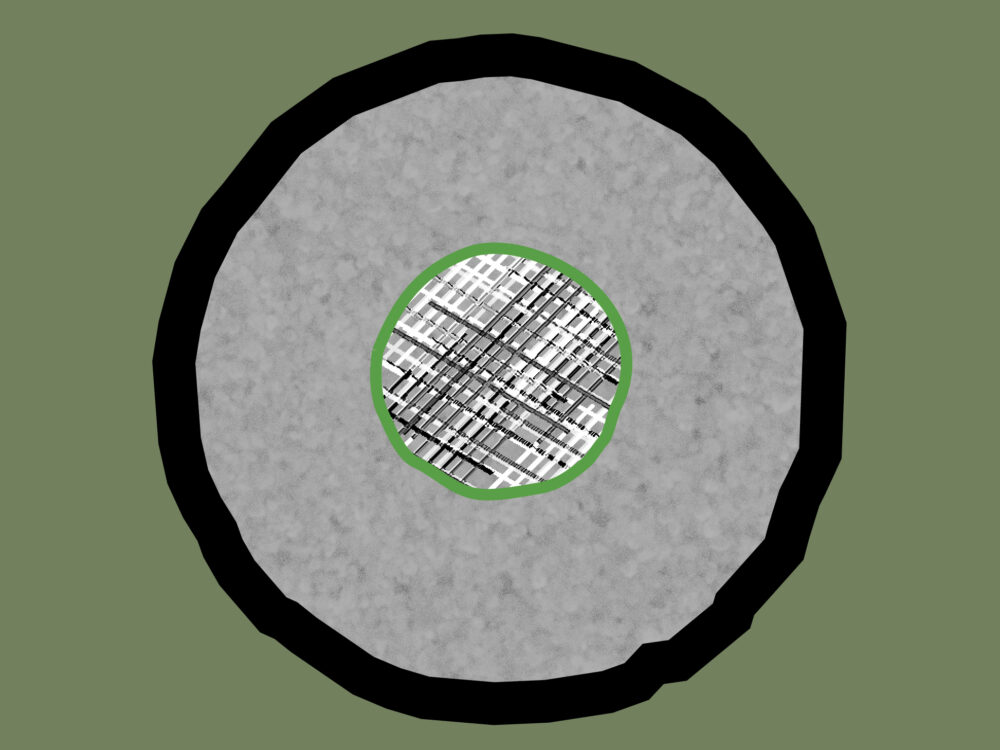
Undisturbed Asteroid
An asteroid that has not been broken apart in collisions may have a core, mantle, and crust. Its surface may be smooth or cratered.
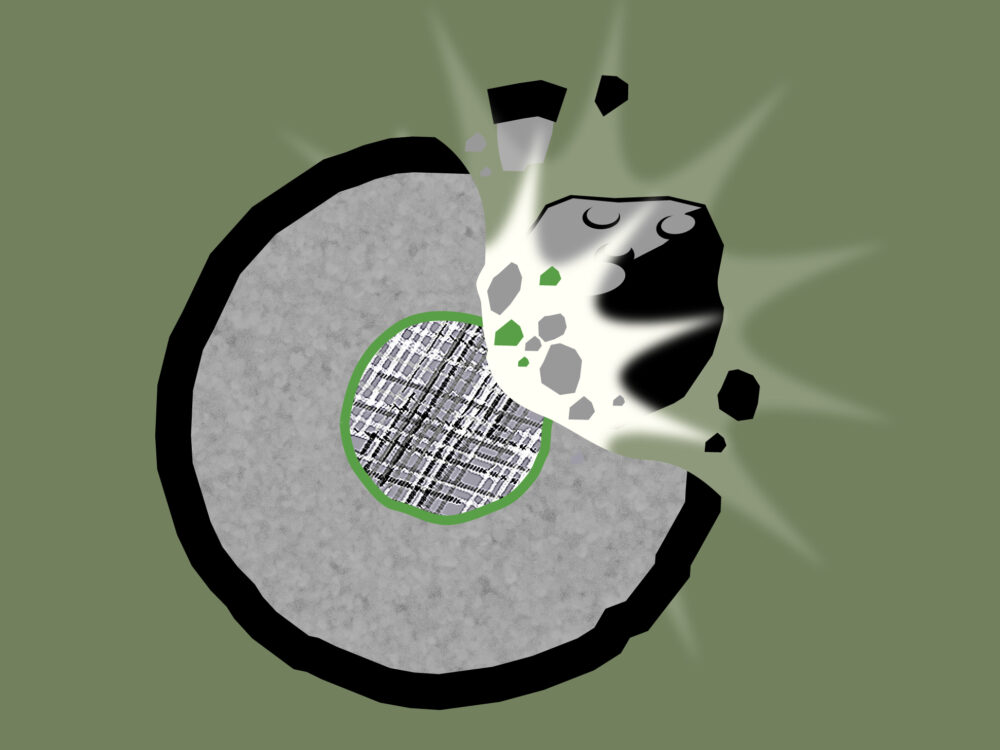
Fragmenting and Asteroid
Collisions break apart large asteroids, scattering fragments through space. The mineral content of each piece tells us where it formed in the original asteroid.
Types of Meteorites
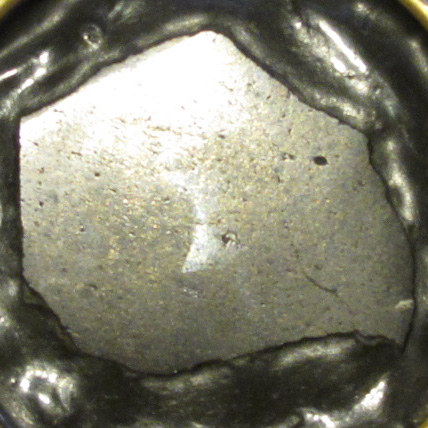
Stony Meteorites
More than 85 percent of meteorites that fall to Earth are stony. They originate in asteroids with mantles and crusts, and contain minerals similar to those in Earth rocks. Some meteorites formed when rock inside their parent asteroids melted completely. Others came from partially melted rock, while the rest originated in asteroids that never melted. Many meteorites contain chondrules, spheres of minerals that are among the oldest unchanged materials in the solar system.
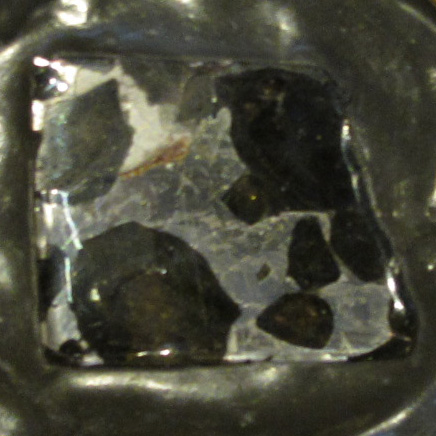
Stony-Iron Meteorites
Many stony-iron meteorites come from the thin zone of melted rock that lies between an asteroid’s mantle and core. These meteorites contain droplets of the silicate mineral olivine trapped in the iron This translucent, olive-green mineral forms in heated rocks and is common on Earth. Meteorites with olivine in them are rare and beautiful.
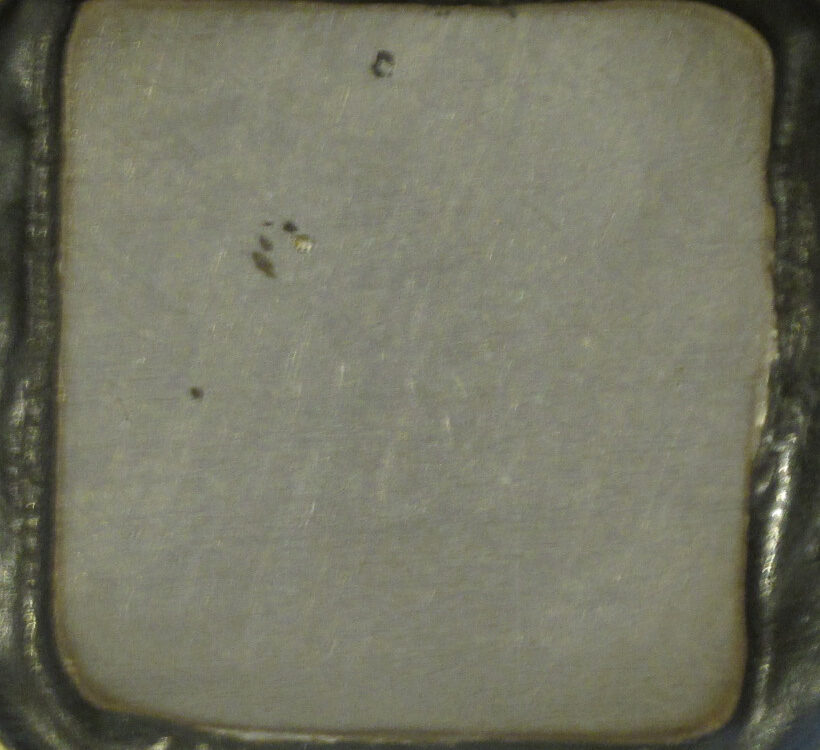
Iron Meteorites
These meteorites come from the heavy iron cores of layered asteroids. They are scattered throughout space when collisions smash their parent bodies into pieces.
In asteroids that melted, iron sank to the cores. Over long periods of time, the cores cooled slowly, allowing iron crystals to grow. These crystals show up as cross-hatched patterns when an iron meteorite is sliced, polished, and etched with acid.


Meteorite Impacts
Comets and asteroid fragments have hit all of the solar system’s planets and moons. We find impact craters everywhere.
Impacts shape the surfaces of worlds. Craters are the scars left on planetary landscapes by impacts and collisions. The size of an incoming object affects the size of the “splash” it makes and the amount of ejected material deposited around the site. Craters range from microscopic pits made by very small projectiles to huge holes in the ground made by very large objects.
On Earth, the largest objects to survive a trip through our atmosphere blast out huge impact scars. Early in its history, Earth was bombarded by countless incoming objects. Most of the craters left over from those ancient impacts have eroded away or been covered by lava flows and vegetation. Only a few obvious ones remain. The Moon and other airless worlds are pockmarked with craters of all sizes. Without erosion by wind and rain, those pits remain intact for billions of years and preserve the cratering history of the solar system.

When a large incoming body hits Earth, the result is a crater. The force and pressure of the collision vaporize parts of the meteorite, as well as the ground it hits. The impact blasts out the crater, melts some of the rock, and scatters fragments far and wide.
Meteorite Impacts Can Create Tektites
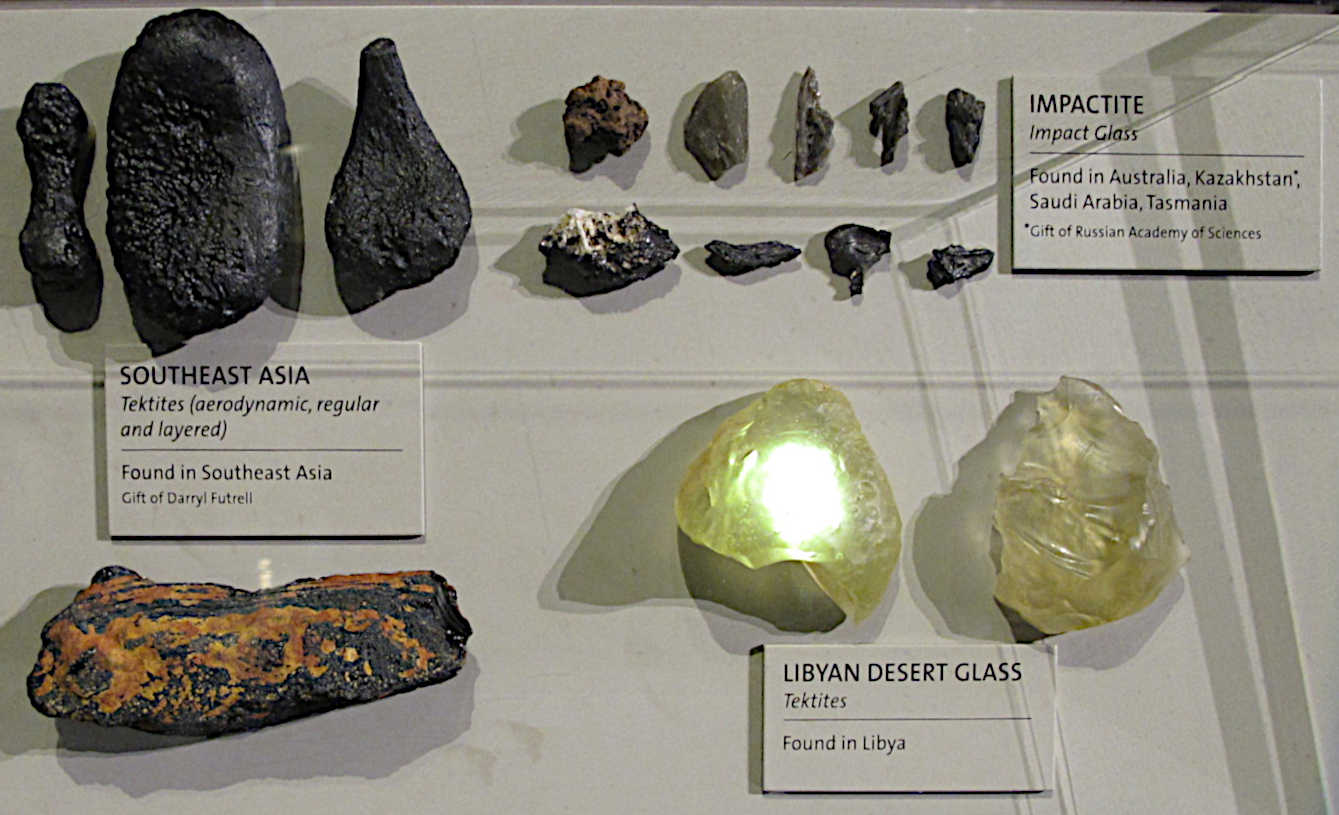
An impact digs up surface material and blasts it away. During large collisions, a lot of heat gets generated, which melts rock. Some of this “impact melt’ flows away, while some is blasted into the air with the rest of the ejected rocks and meteorite fragments. As the airborne splash of hot liquid rock fall back to Earth’s surface, they cool into interesting shapes. These bits of melted earth are tektites, and each sample contains different materials formed under unique conditions.
Tektites are found in a few scattered locations on Earth. These Bediasites were found in Texas. The Libyan Desert Glass is strewn across the northern African deserts. Moldavites come from the Czech Republic and neighboring countries.
An Impact Killed the Dinosaurs
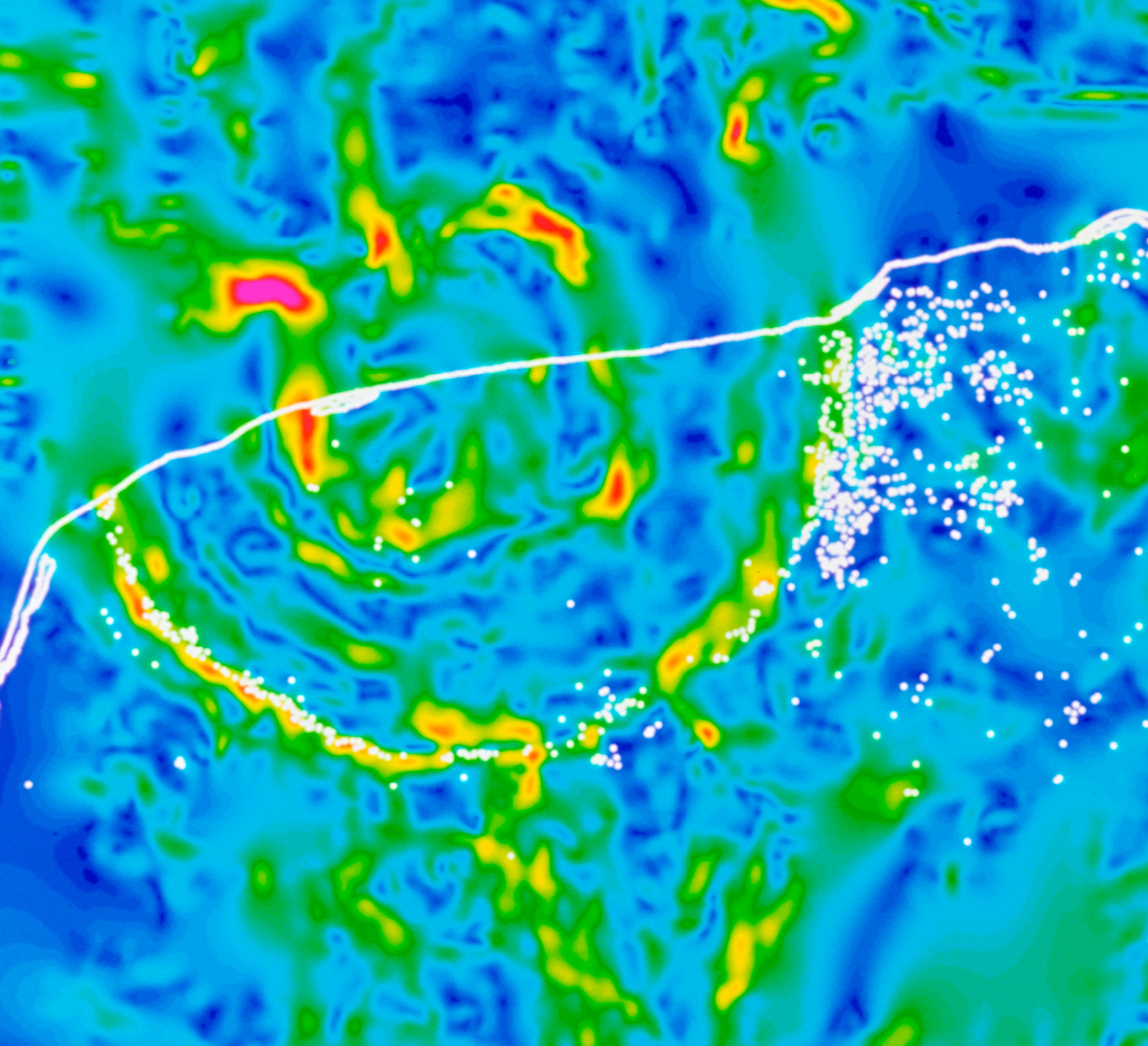
Sixty-five million years ago, the dinosaurs and other animals died off. This extinction probably happened because a huge asteroid or comet struck the ancient shoreline of the Yucatán Peninsula in Mexico. It hit with the force of a 100-million-megaton bomb and made a crater 60 miles (97 km) across.
The impact raised dust that blocked incoming sunlight. Temperatures fell, and plant photosynthesis was interrupted. The hostile conditions and food shortages helped kill off most of Earth’s animals.
We find evidence for the impact in the K/T Boundary, a layer of clay deposited around the time of the extinction. It is rich with rare elements like iridium that most likely originated in a rock from space.
Canadian Nickel Mine
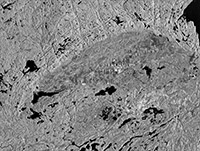
A huge Canadian nickel mine lies at the site of an ancient asteroid impact. Almost 2 billion years ago, an asteroid crashed into central Canada, near the current town of Sudbury, Ontario. It vaporized a chunk of Earth’s crust and created a crater 12 miles (19 km) deep. The impact tore away rock layers and exposed Earth’s upper mantle. This allowed metal-bearing magma to flow to the surface. Today we find rich deposits of nickel, copper, and platinum on the site. Near the point of impact, rock melted instantly, flowed as liquid, and cooled into black melt glass. The impact also tossed out fragments of bedrock and pieces of the meteorite, which fell back to the area surrounding the crater.
Shattercones: Proof of an Ancient Impact
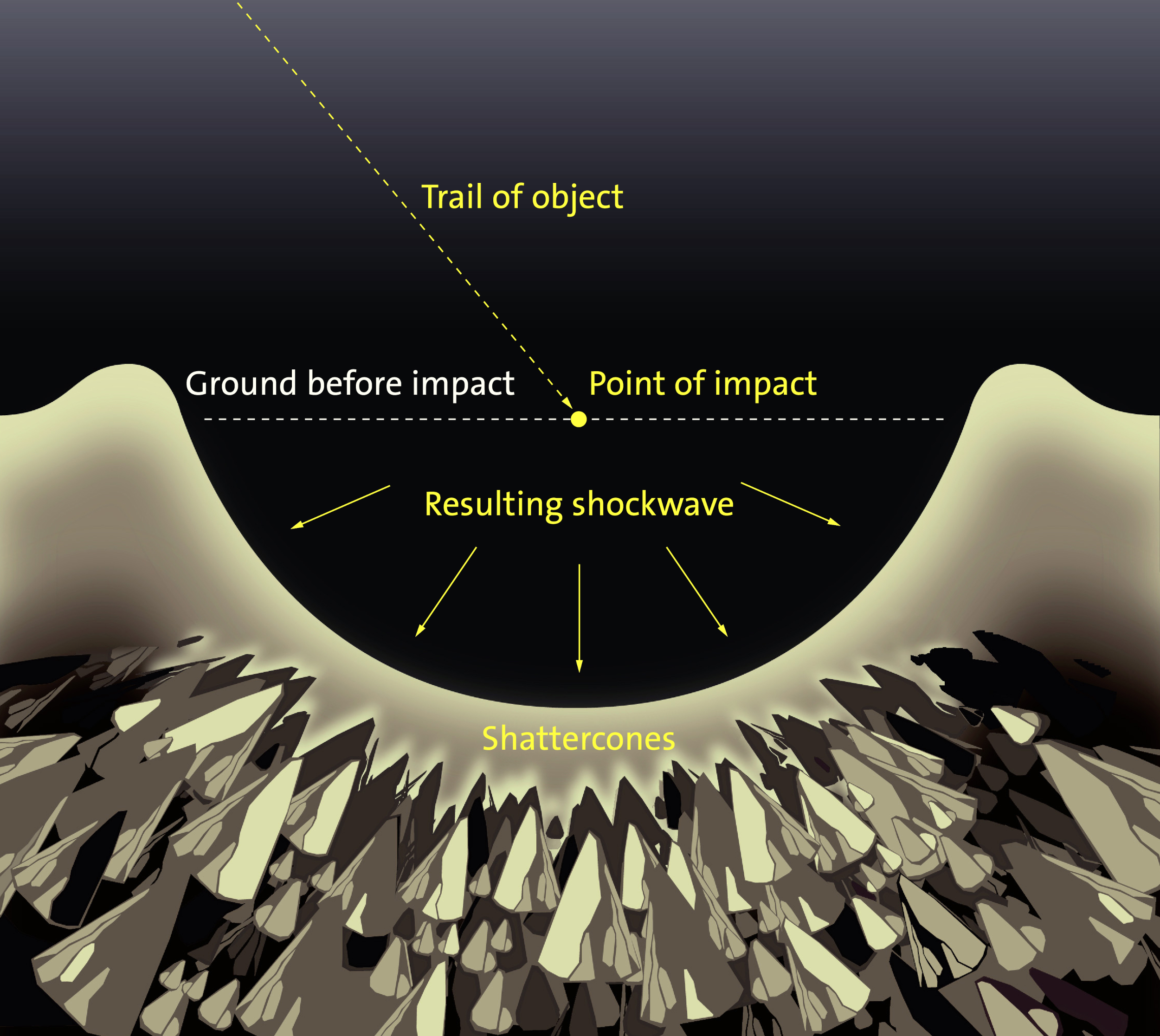
Shattercones are shock waves preserved in stone. They occur when an impact blasts into layers of bedrock and puts the rock under tremendous pressure. It shatters, creating three-dimensional cone-shaped patterns. The tips of the cones point back to the impact source.
When Meteorites Attack!
In 1954, a fragment of an asteroid crashed through the roof of a house in Sylacauga, Alabama. It bounced off the floor and hit Ann Hodges while she was napping on her couch. She was the first person documented to have been struck by a meteorite. Mrs. Hodges sold autographed pictures of herself holding the meteorite under the damaged ceiling. The rock is now on display in the University of Alabama’s Natural History Museum.
A Meteorite Meets a Carport
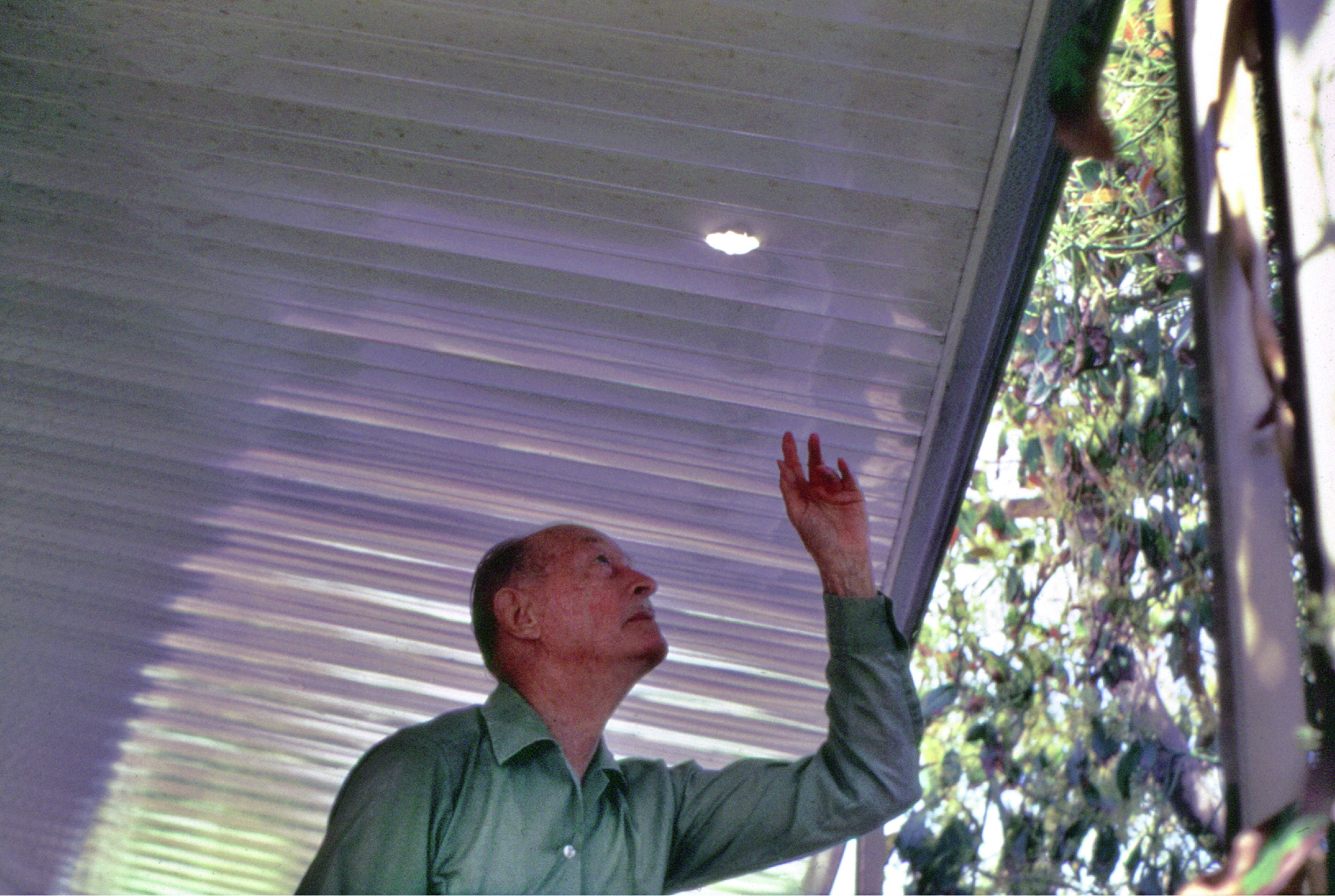
Impacts come when you least expect them. In 1973, a carport roof in San Juan Capistrano, California, took a hit from an asteroid fragment. Owner George Stinchcomb reported hearing a sound like a gunshot in the middle of the night. The next morning, he found an egg-size meteorite that crashed through the carport roof onto the concrete floor.


California Meteorites
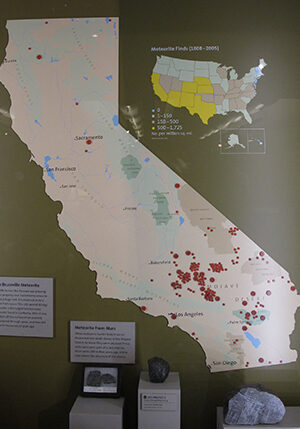
California has many rich meteorite grounds. The most successful hunters use very thorough search techniques.
Meteorites have been found all over the Golden State, but many collectors go hunting in California’s flat, dry lakebeds. Rocks that land in these desert areas often remain visible and undisturbed indefinitely.
Successful meteorite hunters are methodical in their searches. They lay out grids at each site and then systematically examine every square foot for unusual stones. This is not easy because conditions can be very hot and dry. The hunters photograph meteorites exactly where they find them and record each location with a detailed description. The best teams can find several meteorites a day. The large numbered dots on the map (right) represent the California meteorites in Griffith Observatory’s collection. The small dots document other finds in the state.
The Bruceville Meteorite
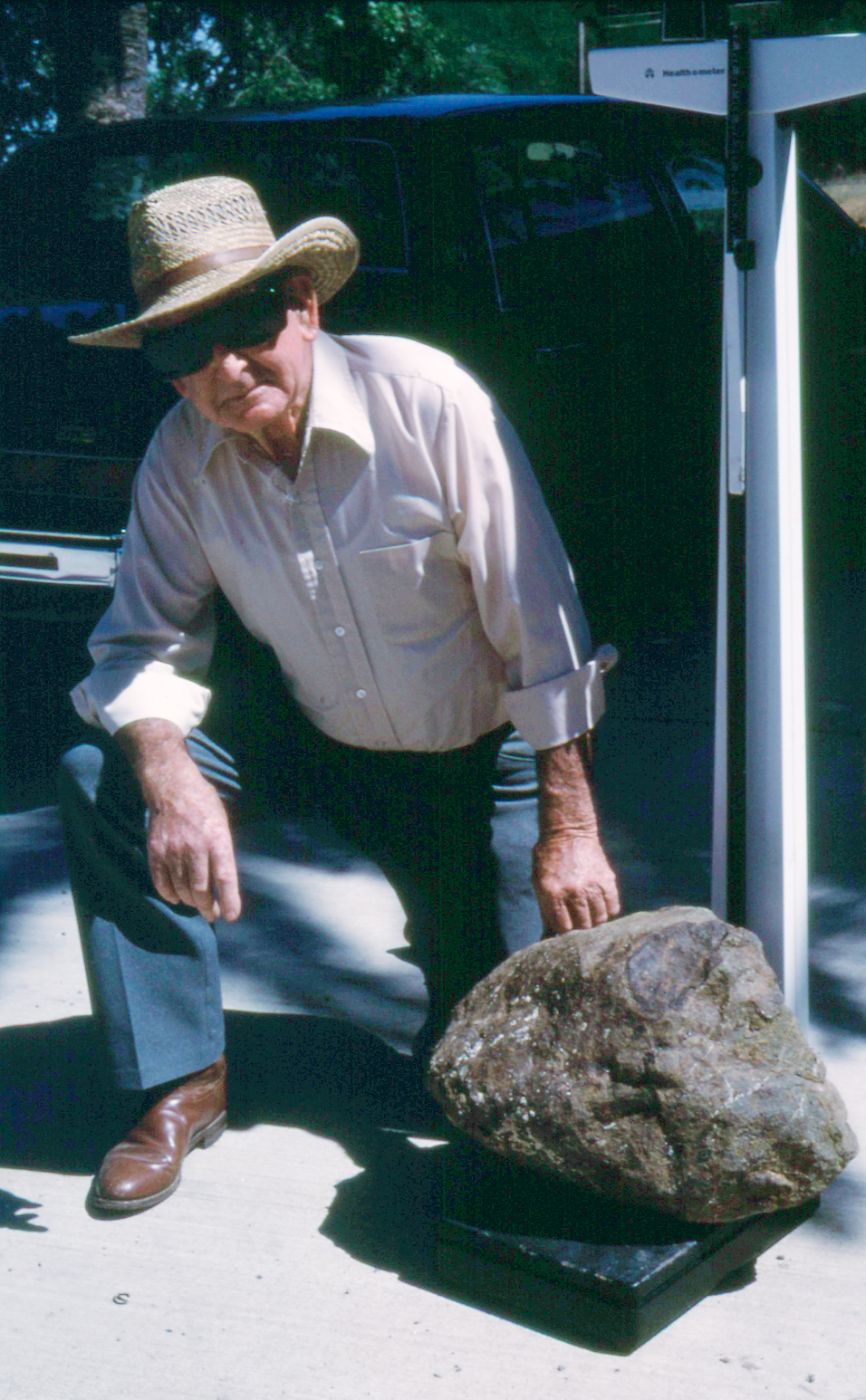
In 1998, farmer Ben Howard was plowing on his property near Sacramento when he struck a huge rock. It turned out to be a visitor from space. This 183-pound (83-kg) meteorite is the largest-known stony meteorite found in California. After it was knocked off the surface of an asteroid, it wandered through space, and then fell to Earth thousands of year ago.
Meteorite From Mars
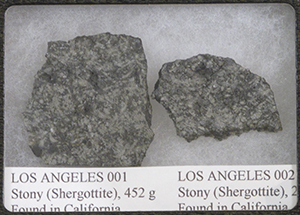
When meteorite hunter Robert Verish discovered two small stones in the Mojave Desert, he knew they were unusual. These rocks were once part of a lava river on Mars some 180 million years ago. A thin slice shows the structure of the stones.
How Meteorite Hunters Know Where to Look for Their Quarry
Although countless meteorites fall to Earth each year, finding them is tricky. They land everywhere, but if they plunge into the ocean or drop into forests and fields, they are probably lost forever. The best meteorite hunting grounds are places where these rocks stand out against the landscape: the deserts of Australia, Africa, and the Middle East; the frozen fields of Antarctica; and the dry lakebeds of California and the American southwest.
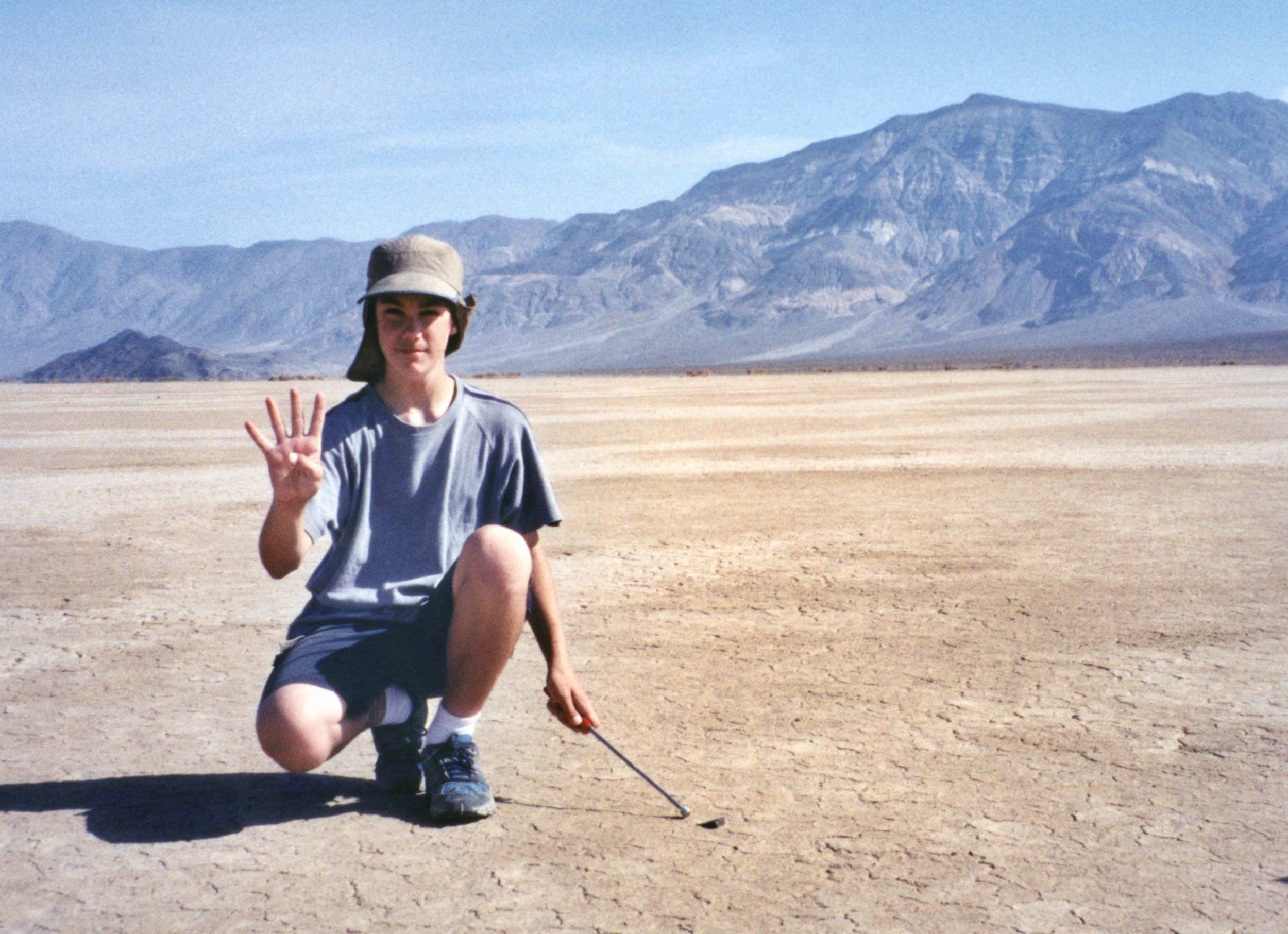
Meteorites can be hidden by Antarctic snow for years. Every year, expeditions hunt for them on the ice fields during summer in the southern hemisphere. The meteorites that fall in the world’s deserts and on dry lakebeds can lie undisturbed until hunters like Jason Utas find them. Here, he signals his fourth find of the day at a lakebed site in eastern California.
Peter and Jason Utas found this meteorite near Barstow, California, embedded in dry lakebed mud as you see it here. They dug up the soil sample without removing the meteorite to show how it really looked.
How to Recognize a Meteorite
Not every strange-looking rock is a meteorite. The weight of a rock, the minerals it contains, the way its surface looks, and the place where it was discovered all help meteorite hunters determine whether a lucky find came from space.


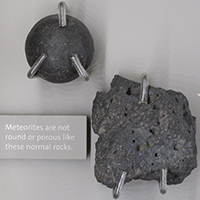
Meteorites are not round or porous like these normal rocks.
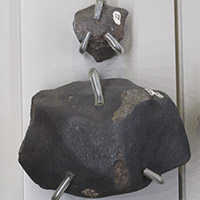
Stony and iron meteorites can have melted, glassy surfaces. Some have pits and markings.
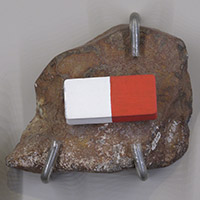
An iron meteorite will attract a magnet. Some stony meteorites are also slightly magnetic.
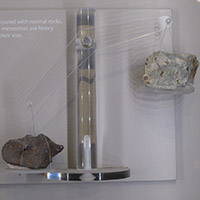
Compared with normal rocks iron meteorites are heavy for their size.